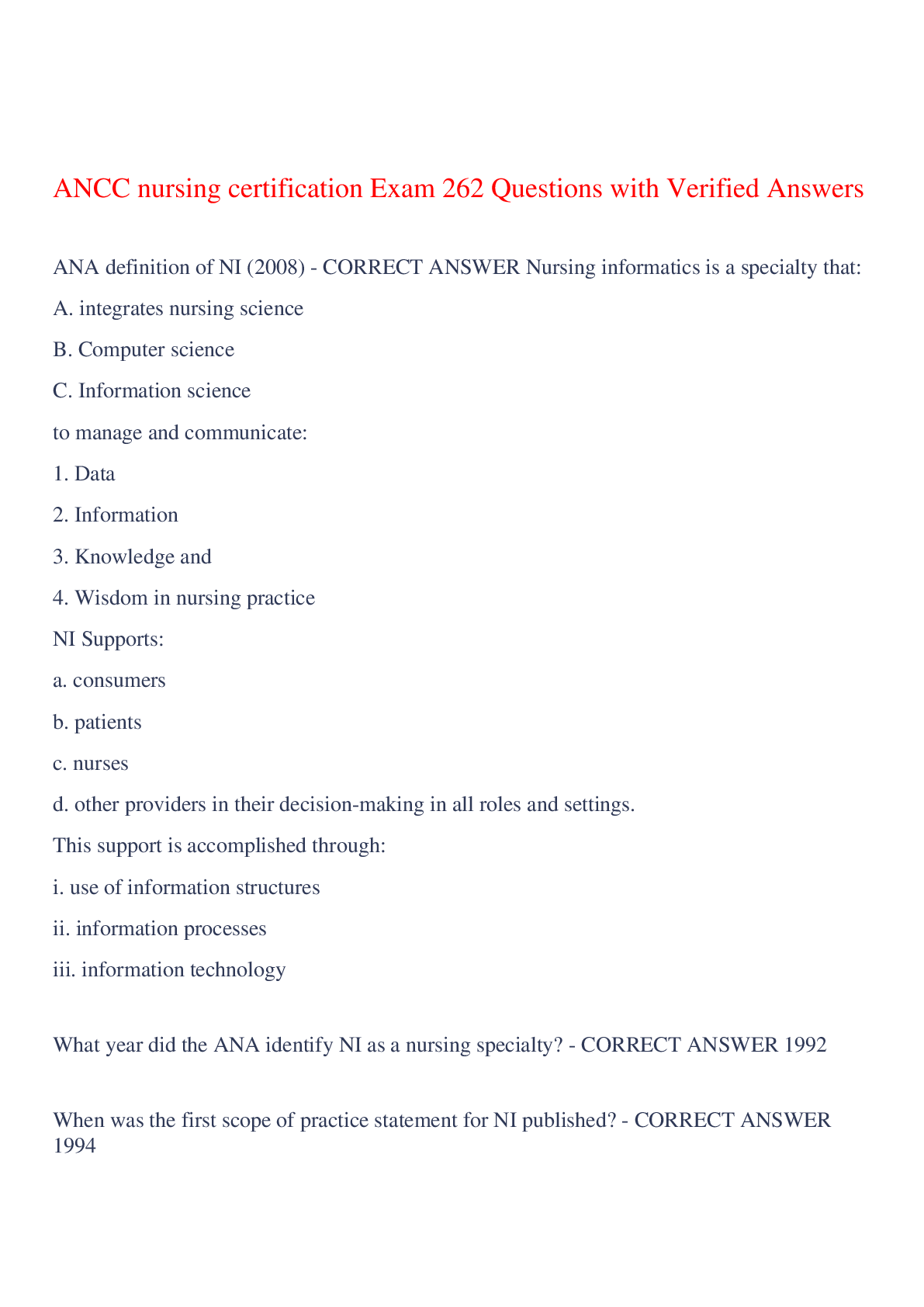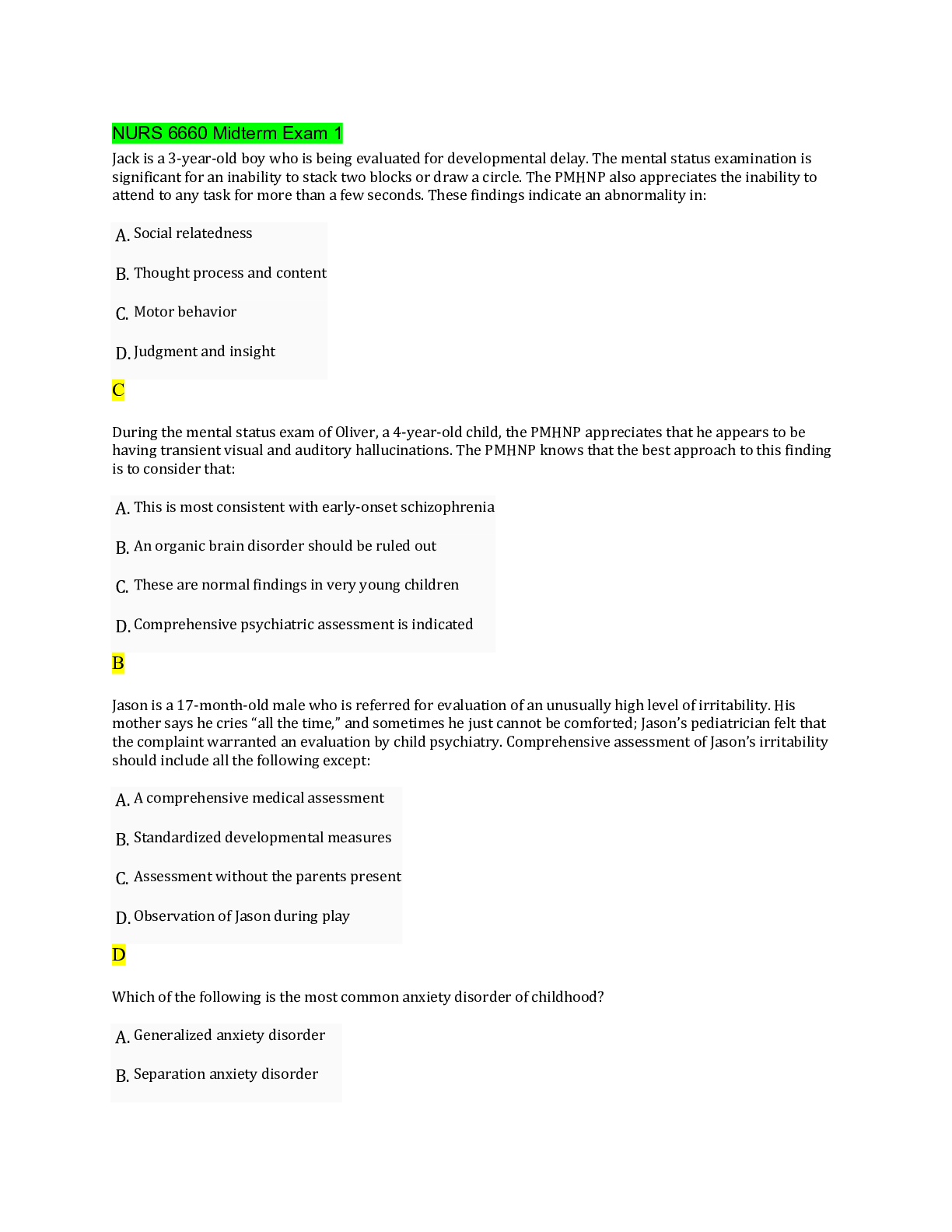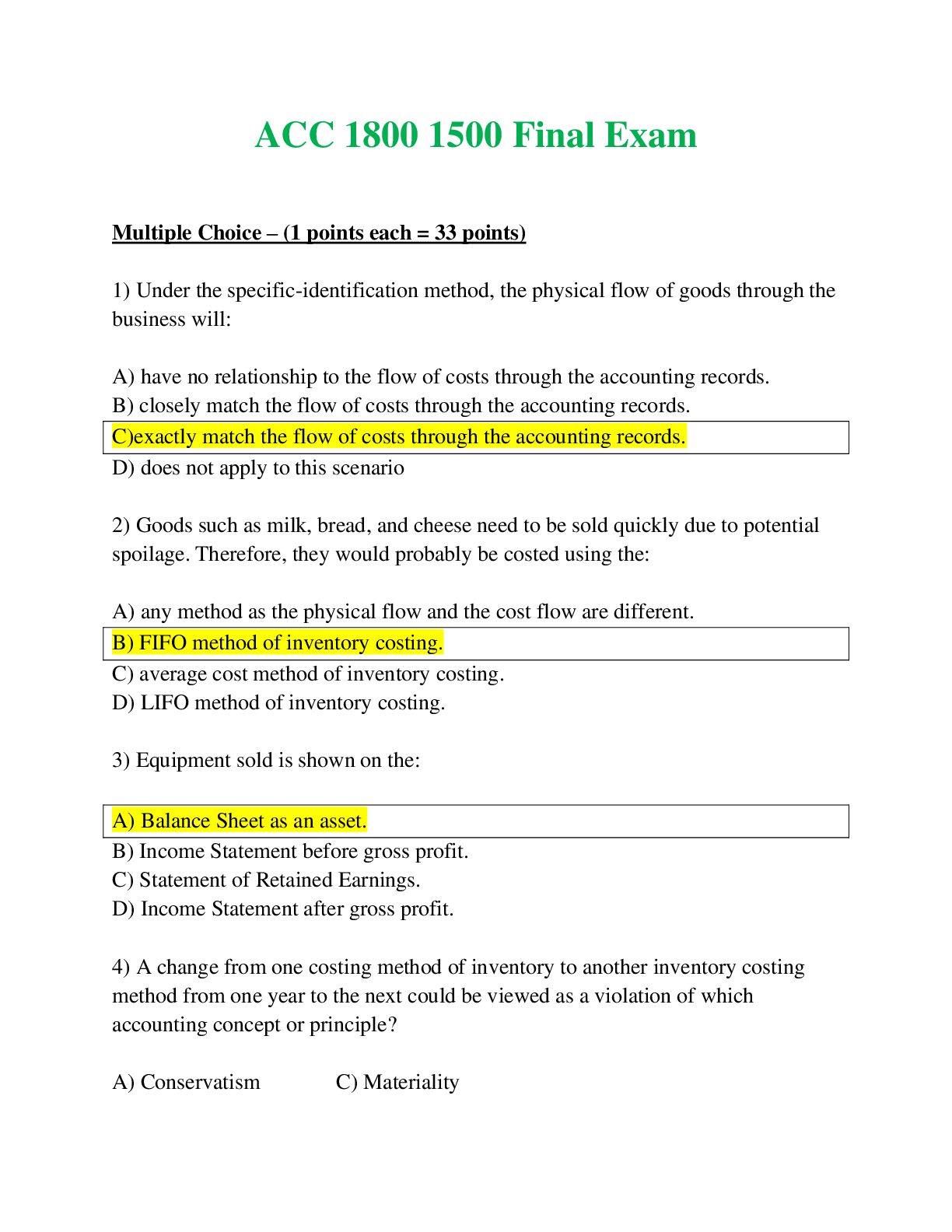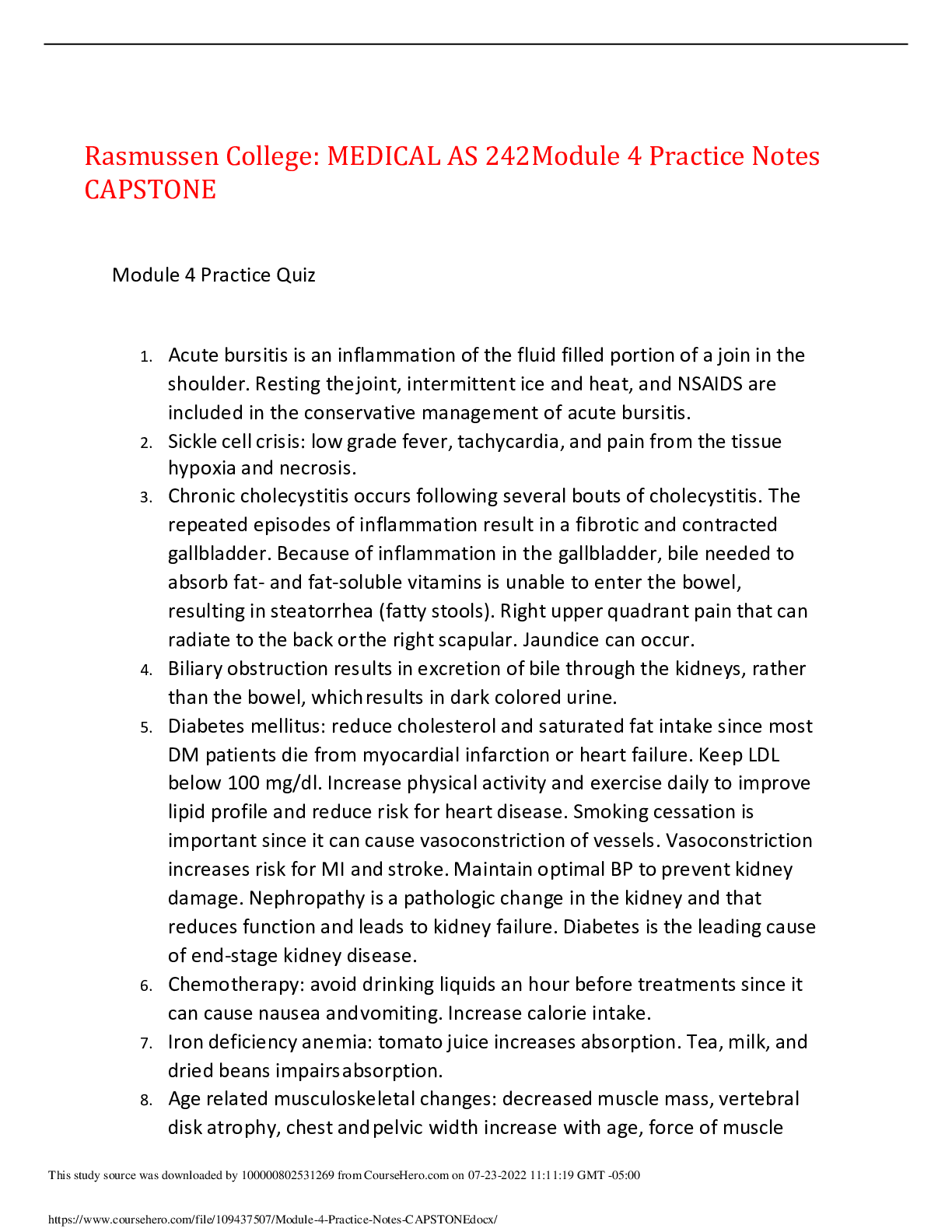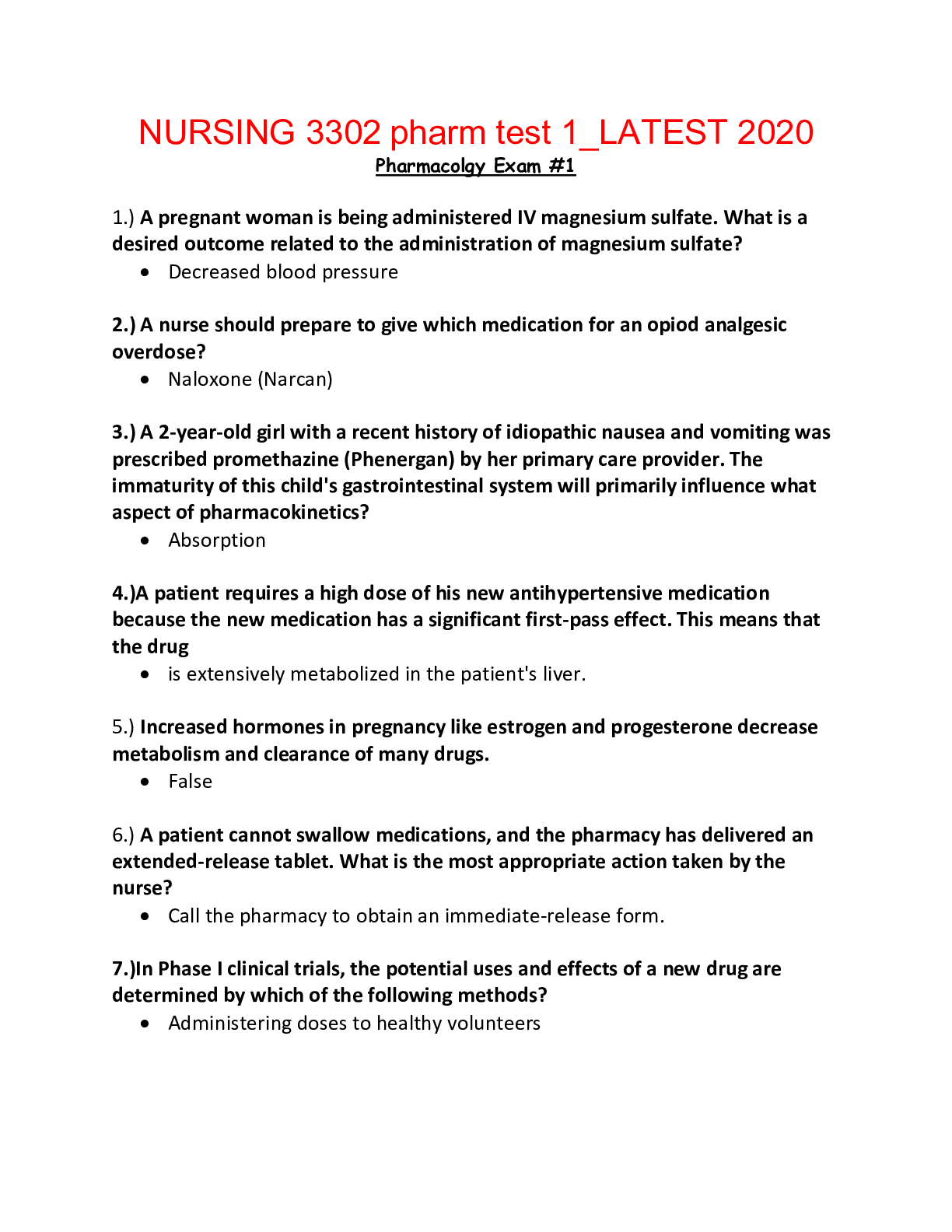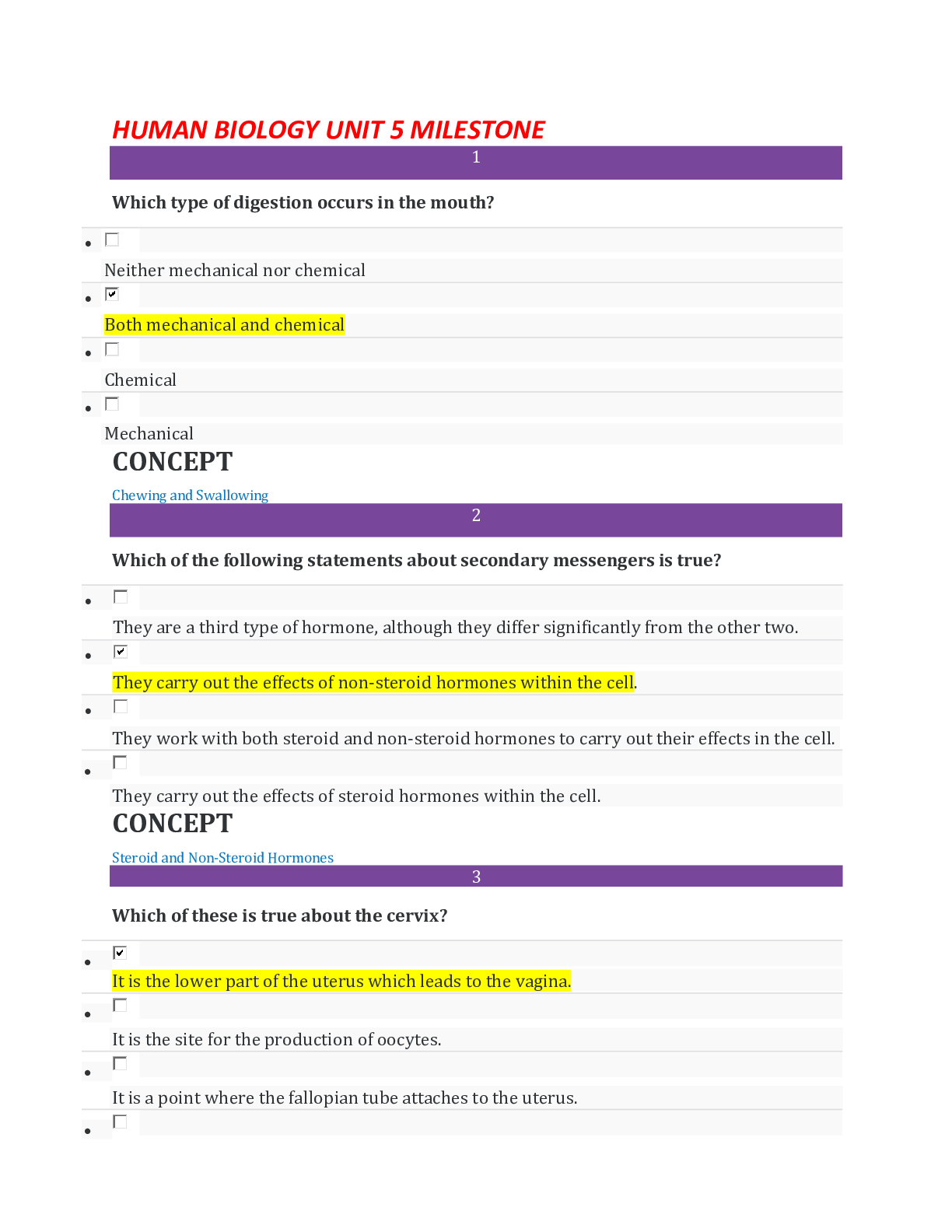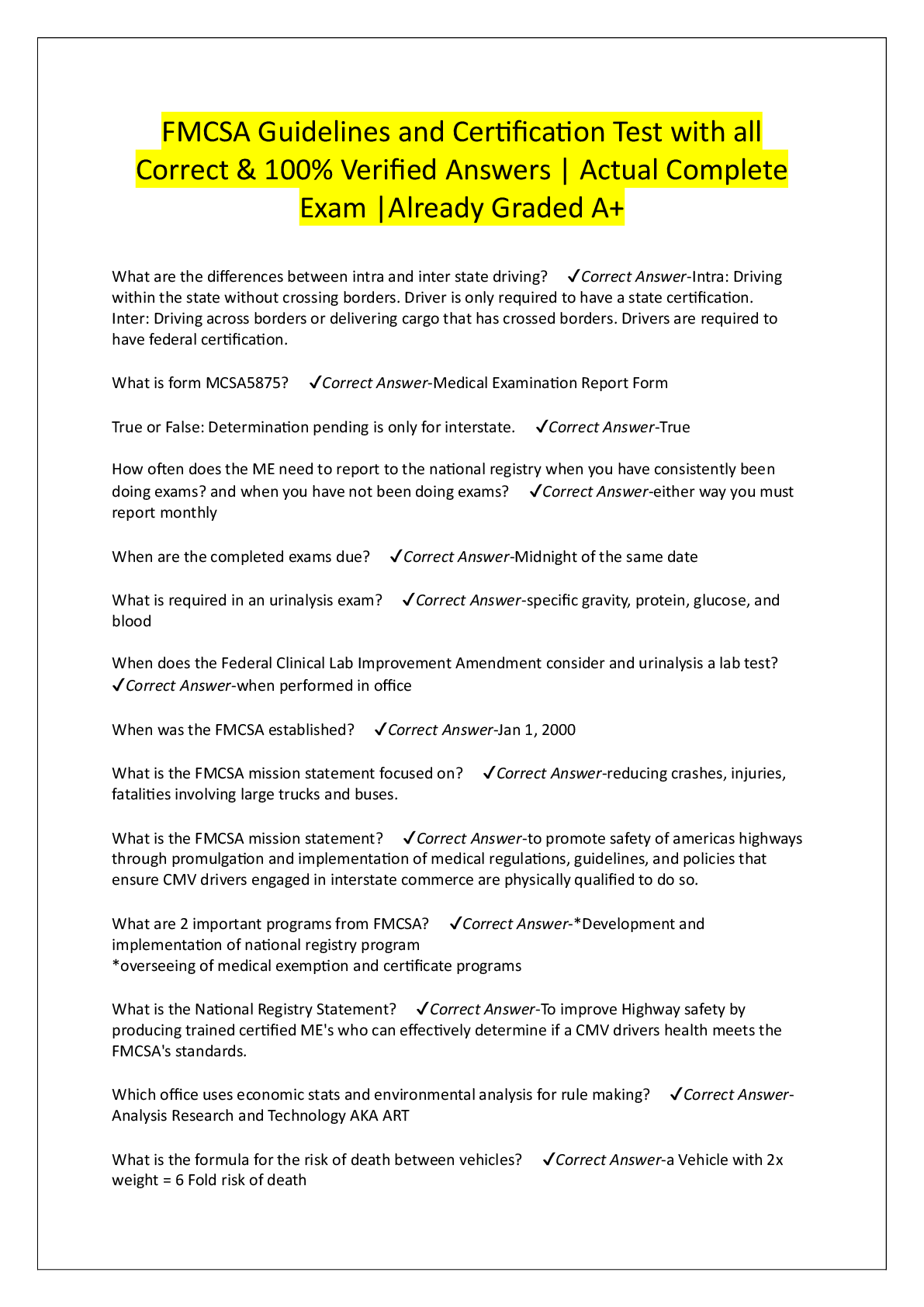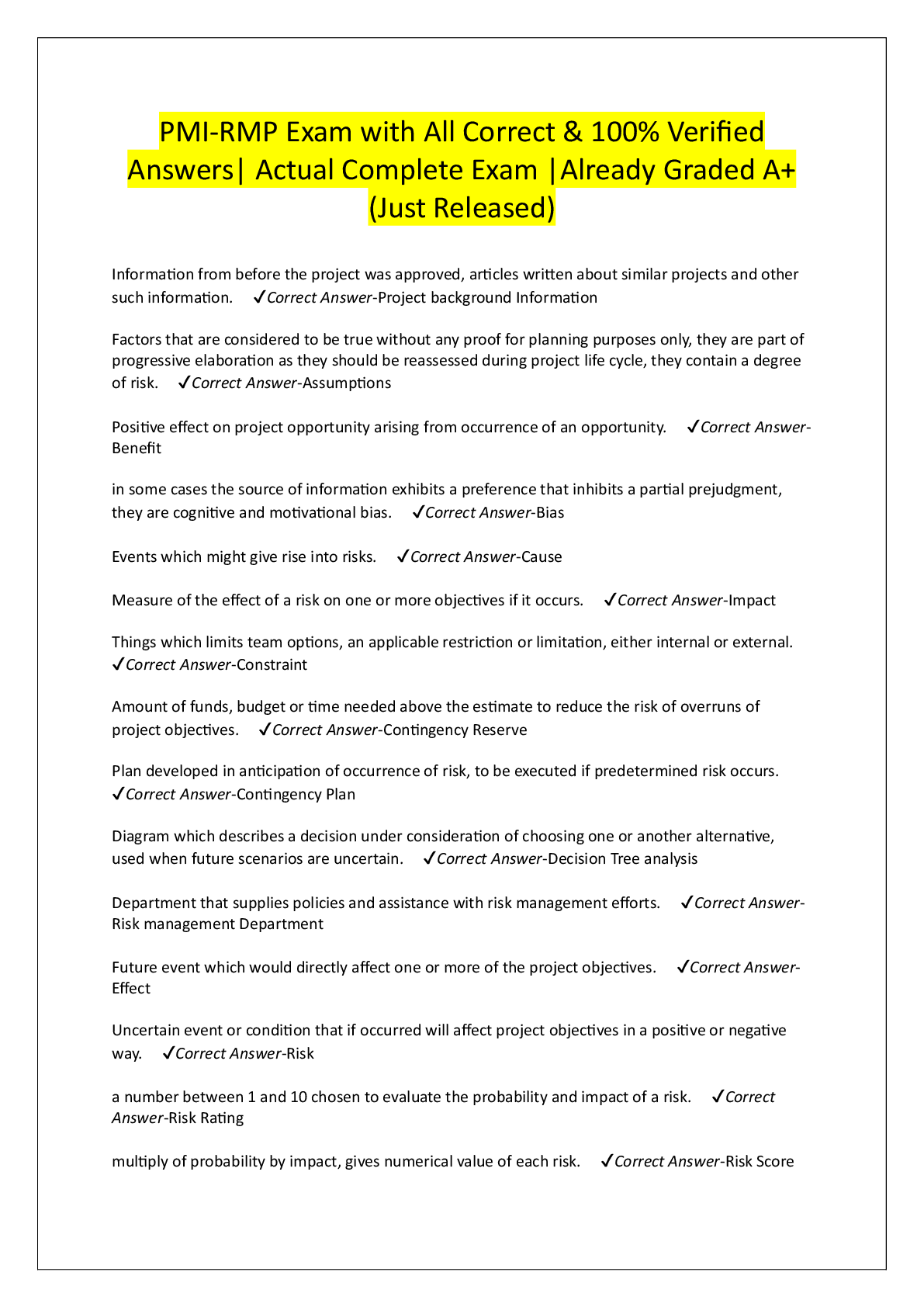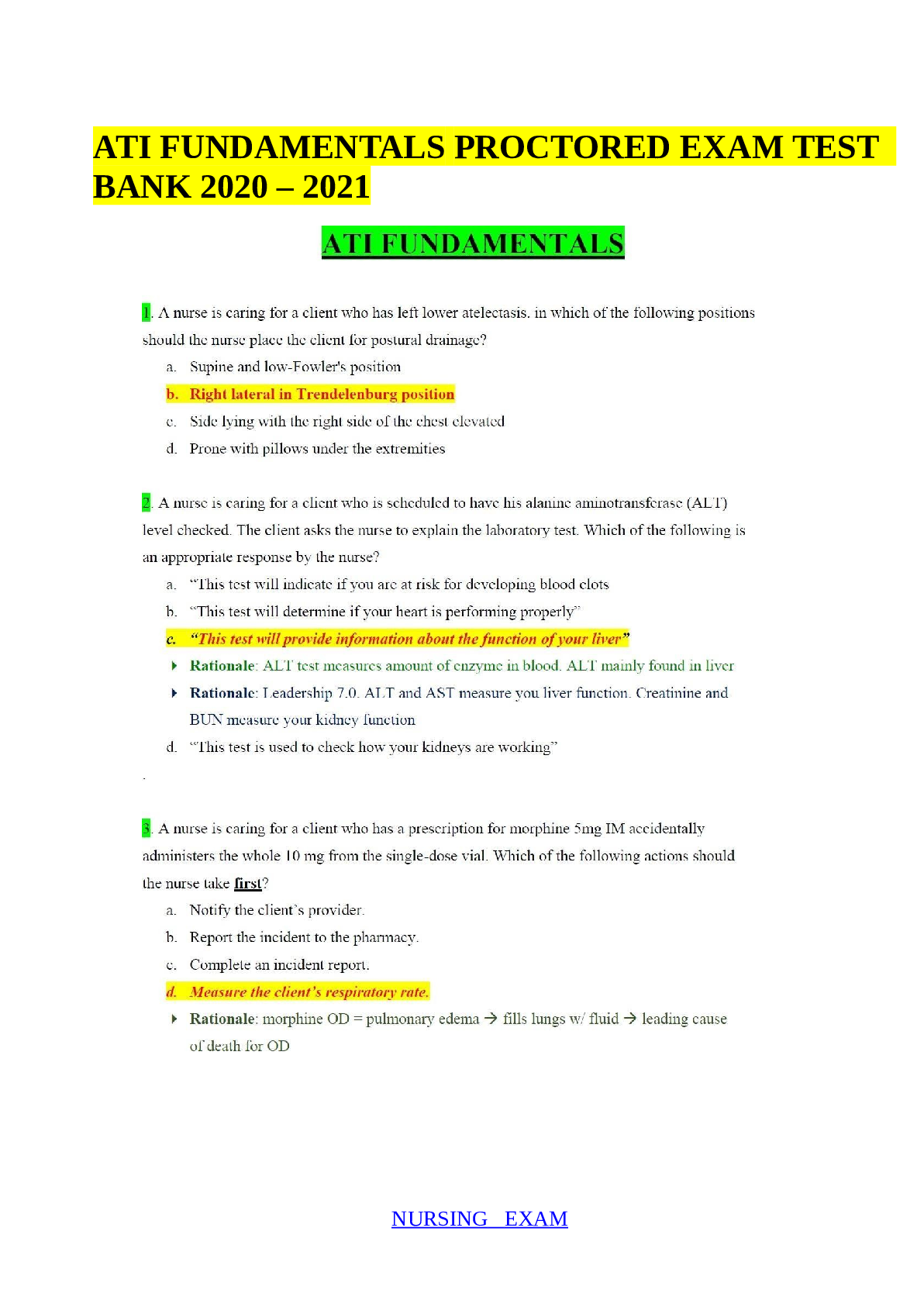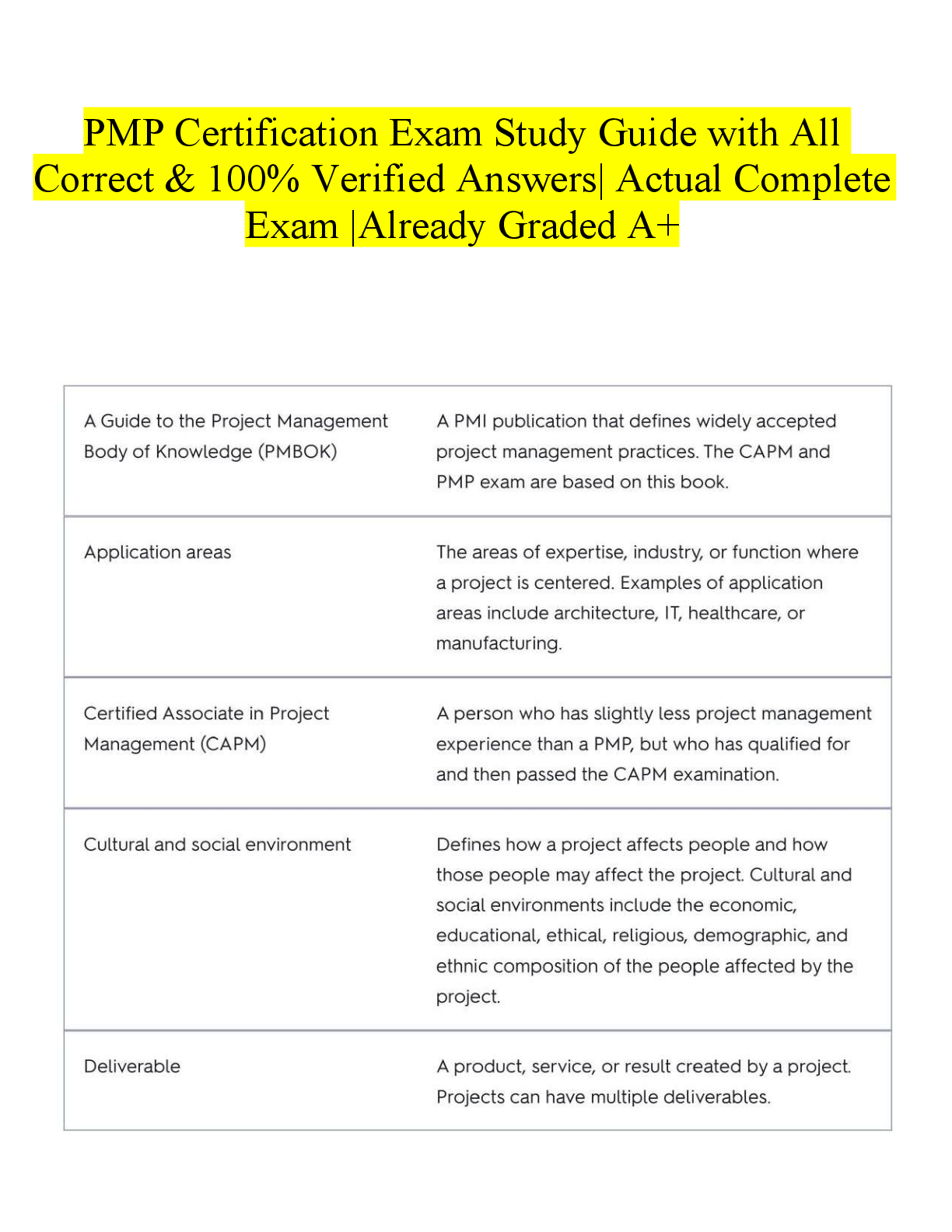ANCC nursing certification Exam 262 Questions with Verified Answers,100% CORRECT
Document Content and Description Below
ANCC nursing certification Exam 262 Questions with Verified Answers
ANA definition of NI (2008) - CORRECT ANSWER Nursing informatics is a specialty that:
A. integrates nursing science
B. Computer
...
science
C. Information science
to manage and communicate:
1. Data
2. Information
3. Knowledge and
4. Wisdom in nursing practice
NI Supports:
a. consumers
b. patients
c. nurses
d. other providers in their decision-making in all roles and settings.
This support is accomplished through:
i. use of information structures
ii. information processes
iii. information technology
What year did the ANA identify NI as a nursing specialty? - CORRECT ANSWER 1992
When was the first scope of practice statement for NI published? - CORRECT ANSWER 1994
ANA definition of NI - CORRECT ANSWER Specialty that integrates nursing science with multiple informative and analytical sciences to identify, define , manage and communicate data information, knowledge, and wisdoms in nursing practice
What are the foundations of practice - CORRECT ANSWER A. Professional practice
B. Methodologies & Theories
C. Rules, regulations, & requirements
D. Interprofessional collaboration
ANA definition of NI (2015) - CORRECT ANSWER NI is a specialty that integrates nursing science with multiple information and analytical sciences to:
A. Identify
B. Define
C. Manage and
D. Communicate data, information, knowledge, and wisdom in nursing practice
NI supports:
1. Nurses
2. Consumers
3. Patients
4. Users
5. Interprofessional healthcare team
6. Other stakeholders in their decision-making roles and settings to achieve desired outcomes
This support is accomplished through the use of:
a. information structures,
b. information processes, and
c. information technology
Tenents (beliefs) of Nursing Informatics - CORRECT ANSWER 1. A unique body of knowledge, preparation, and experience that aligns with the nursing profession.
2. Involves the synthesis of data & information into knowledge & wisdom
3. Supports decision-making of healthcare consumers, nurses, and other professionals achieve healthcare consumer safety and advocacy
4. Supports data analytics, including quality of care measures, to improve population health outcomes and global health
5. Promotes data integrity and the access and exchange of health data for all consumers of health information
6. Supports national and international agendas of interoperability and the efficient and effective transfer and delivery of data, information, and knowledge
7. Ensures that collaboration is an integral characteristic of practice
8. Interleaves user experience and computer-human interaction concepts throughout practice
9. Incorporates key ethical concerns of NI such as advocacy, privacy, and assurance of the confidentiality and security of data and information
10. Considers the impact of technological changes on patient safety, healthcare delivery, quality, reporting, and the nursing process
11. Leads in the design and promotion of useful, innovative information technologies that advance practice and achieve desired outcomes(Scope & Standards )
When was the ANA Standards of Practice for NI released? - CORRECT ANSWER 1995
When was the scope and standards of NI practice released combining both scope and standards of practice? - CORRECT ANSWER 2001 then updated in 2008
What are analytical sciences? - CORRECT ANSWER A listing of sciences that integrate with NI includes:
1. computer science
2. cognitive science
3. science of terminologies and taxonomies (including naming and coding conventions)
4. information management
5. library science
6. heuristics
7. archival science
8. mathematics
What are the NI competencies for all RNs? - CORRECT ANSWER TIGER-Technology informatics guiding education reform identified that all nurses in every role must be prepared to make HIT. TIGER formed an informatics competency collaborative which defines the competencies recommended for the NI discipline:
1. Basic computer skills
2. Information literacy
3. information management
According to Staggers, Gassert, Curran 2002, what are the levels of informatics competencies? - CORRECT ANSWER 1. Beginning nurse
2. Experienced nurse
3. Informatics nurse specialist
4. Innovator
Name some additional competencies - CORRECT ANSWER 1. Pierce, Tanner, & Pravikoff (2005) information literacy
2. Telehealth competencies (ATA, ICN)
3. Genetics & genomics competencies
4. National league for nursing
5. Amer Assoc of College of Nurses
6. Forecasting informatics competencies for nurses in the future of connected health IOS Press 2017
Name the types of roles - CORRECT ANSWER 1. Project manager
2. Decision support/outcomes
3. Educator
4. Product developer
5. Systems analyst
6. Consultant
7. Programmer
8. Advocate/policy developer
9. Web developer
10. CIO/CNIO
11. Entrepreneur
12. Researcher
13. Sales and Marketing
14. Consumer advocate
What are the functional areas: Informatics nurses - CORRECT ANSWER 1. Administration, leadership, & management
2. Systems analysis & design
3. Compliance & integrity management
4. Consultation
5. Coordination, facilitation, & integration
6. Development
7. Educational & professional development
8. Genetics & genomics
9. Information management/operational architecture
10. Policy development & advocacy
11. Quality & performance improvement
12. Research & evaluation
13. Safety, security & environmental health
What are the standards of nursing informatics Practice? - CORRECT ANSWER 1. Evaluates quality & effectiveness of NI practice
2. Performance appraisal
3. Maintains knowledge and NI competency-life-long learning
4. Contributes to the professional development of others
5. Bases decisions and actions on ethical principles
6. Collaborates with others
7. Contributes to the body of informatics research
8. 16 Standards are highlighted with measurement criteria
What are the NI Standards of practice? - CORRECT ANSWER Standard 1: Assessment
Standard 2: Diagnosis, Problems & Issues Identification
Standard 3: Outcomes Identification
Standard 4: PlanningStandard 5: Implementation
Standard 6: Evaluation
Standard 7: Ethics
Standard 8: Education
Standard 9: Evidence-Based Practice and Research
Standard 10: Quality of Practice
Standard 11: Communication
Standard 12: Leadership
Standard 13: Collaboration
Standard 14: Professional Practice Evaluation
Standard 15: Resource Utilization
Standard 16: Environmental HealthADOPIEEEEQCLCPRE
What makes up EBP? - CORRECT ANSWER 1. Literature searches
2. Clinical practice guidelines
3. Clinical protocols
Boolean search
Definition of EBP - CORRECT ANSWER *A problem-solving approach to clinical decision-making within a healthcare organization
*Integrates best available scientific evidence with best available experience
*Uses research & non-research evidence (ethical or personal)
Evidence-Based nursing practice is the process: - CORRECT ANSWER By which nurses make a clinical decision using:
1. The best available research evidence
2. Their clinical expertise
3. Patient preferences
Formulating answerable clinical questions is the foundation of EBP. - CORRECT ANSWER 1. Start with the patient: clinical problems & questions arise out of patient care
2. Translate the clinical questions into a searchable question using PICOT
3. Decide on the best type of study to address the question
4. Perform a literature search in the appropriate sources
What is the PICOT model to support EBP - CORRECT ANSWER P-Population/condition
I-Intervention
C-Comparison
O-Outcome
T-Time of study
What is the ACE Star Model of EBP (2004)? - CORRECT ANSWER 5 points of knowledge transformation:
1. Discovery
2. Summary
3. Translation
4. Integration
5. Evaluation
NI support nurses, consumers, patients, interprofessional healthcare team, and stakeholders through the use of which three things? - CORRECT ANSWER 1. Information structures
2. Information processes
3. Information technology
Name a Metastructure - CORRECT ANSWER DIK (Blum-1986)
1. Data
2, Information
3. Knowledge
4. WisdomDIKW (Graves & Corcoran-1989)
What is Data? - CORRECT ANSWER Discrete entities that are described objectively with interpretation
What is Information? - CORRECT ANSWER Data that have been:
1. Interpreted
2. Organized or
3. Structured
What is Knowledge? - CORRECT ANSWER Information that is synthesized so that relationships are identified and formalized
Focuses on what is known
The appropriate use of knowledge involves? - CORRECT ANSWER Integration of empirical, ethical, personal, and aesthetic knowledge into actions
What is Wisdom? - CORRECT ANSWER The appropriate use of knowledge to manage and solve human problems.
It consists of knowing when and how to apply knowledge to deal with complex problems or specific human needs
Focuses on the appropriate application of that knowledge and an appreciation of the consequences of selected actions
Relationship of Data, Information, Knowledge, and Wisdom
Nelson 2002 - CORRECT ANSWER Data - naming, collecting, and organizing
Information - Organizing and interpreting
Knowledge - Interpreting, integrating, and understanding
Wisdom - Understanding, applying and applying with compassion
NI is concerned with - CORRECT ANSWER Creation
Structure
Storage
Delivery
Exchange
Interoperability
Reuse of nursing and clinical information along the continuum of care.
What is the informatics nurse specialist often responsible for? - CORRECT ANSWER Implementing or coordinating projects involving multiple professions and specialties
Support other RNs to best use data, information, knowledge, and technology
NIs support through the use of: - CORRECT ANSWER Information structures
Information processes
Information technology
NIs Foci - CORRECT ANSWER Information user, information recipients, exchange data, information, knowledge, and wisdom
Design, structure, interpretation, and representation of data, information, knowledge, and wisdom
Design, develop, implement, and evaluate applications and technologies, ensuring their safety, quality, effectiveness, efficiency, and usability
Standardized terminologies - CORRECT ANSWER Have become a significant vehicle for facilitating interoperability between different concepts, nomenclatures, and information systems
What is the systems development life cycle (SDLC)? - CORRECT ANSWER *Standardized approach*Process for developing information systems in a: -deliberate -structured -methodical manner
What are the four phases of the SDLC? - CORRECT ANSWER 1. Planning2. Analysis3. Design, Develop, Customize4. Implementation, Evaluate, Maintain, Support
What is a project life cycle? - CORRECT ANSWER 1. Initiating2. Planning3. Execution4. ClosingMay be used in conjunction with the SDLC
What is the Planning phase of the SDLC? - CORRECT ANSWER It is a foundational, fundamental and often longest phase (sets the stage for the project)*system requirements*feasibility study*project charter*project plan
In the Planning phase of the SDLC, what are the system request components? - CORRECT ANSWER 1. Project sponsor2. Business need3. Business requirements4. Business value5. Special issues/considerations
In the Planning phase of the SDLC, what are the feasibility analysis types? - CORRECT ANSWER 1. Technical, "can we build it?"2. Economic, "should we build it?"3. Operational, "if we build it, will they use it?"
In the Planning phase of the SDLC, what are the elements of the project charter? - CORRECT ANSWER 1. Project champion2. Dates (start, milestones, end)3. Problems or opportunity statements (purpose/justification)4. Objectives (what we want to achieve)5. Key stakeholders6. Scope of the project7. Target benefit8. Budget
In the Planning phase of the SDLC, what is a project charter? - CORRECT ANSWER 1. Draws from system requests2. Created by project sponsor or initiator (often delegated to the project manager or informatics nurse)3. Formally authorizes the existence of a project4. Authorizes project manager to apply organizational resources
In the Planning phase of the SDLC, what are the goals assessment? - CORRECT ANSWER 1. Return on investment (ROI)-ratio of expected financial gains divided by the total costs2. Cost-benefit analysis (CBA). Attempt to quantify tangible and intangible items3. Tangible-improve revenue, decrease staff needed4. Intangible-increase in patient satisfaction
In the Planning phase of the SDLC, what are the tools used? - CORRECT ANSWER System Selection & Implementation: -customer site visit -surveys -RFI/RFP -Gap analysisSystem/Product Development -Stakeholders analysis -Market survey -Feasibility analysis -Assessment of competitors
In the Planning phase of the SDLC, what is a GAP analysis template? - CORRECT ANSWER A visual tool that involves a comparison of actual performance & potential or desired performance.
In the Planning phase of the SDLC, what is the informatics roles and skills? - CORRECT ANSWER System Selection & Implementation: -Project manager -SME -System analyst -Autor of artifacts: project charter system selection plan RFI/RFPSystem/Product Development -Market/user researcher -SME -Systems analyst -Author of artifacts product concepts scope document feasibility assessments other artifacts of planning -Respond to RFI/RFP
In the Planning phase of the SDLC, what is an RFI? - CORRECT ANSWER *Is it a request for information*A document that the organization sends to vendors*Indicates interest in gaining knowledge about the vendor's product*Lists (high level) the key features desired for the new system*Vendor responds to RFI w/their products ability to meet these high-level requirements
In the Planning phase of the SDLC, what is an RFP? - CORRECT ANSWER *Request for proposal*Created by the project team*Sent to selected vendors requesting greater and more detailed information about the features/functions desired for the new system*Response from vendor from an RFP are equally detailed*Supports comparison of vendors
In the Planning phase of the SDLC, what are outputs? - CORRECT ANSWER System Selection & Implementation -system request -feasibility assessment -charter -team formation proj governance structure/implement committee proj team(s) (actually implements the system) -gap analysis -timeline -workplan & resource requirementsSystems/Product Development -feasibility assessment -product scope document what it will and will no contain functionally -product concept document summary of customer needs proposed solution potential market use -In product development, the decision to "go" or "no go" is made in the planning phase
In the Planning phase of the SDLC, what are typical teams and committees? - CORRECT ANSWER Systems Selection & Implementation: -Executive steering committee -Data governance committee -Information technology steering committee -Physician advisory committeeSystems/Product Development: -Project core group or build team(s) -Testing team -Change management/communication team -Training team -Support team
In the Planning phase of the SDLC, what is the purpose of a project charter? - CORRECT ANSWER To formally authorize a project or a phase and document initial requirements which satisfy the stakeholder's needs & expectations.
Categories of competencies with nursing informatics include? - CORRECT ANSWER 1. Basic computer skills2. Information management skills3. Information literacy skills
The foundation of an organizations' strategic system planning begins with a review of the? - CORRECT ANSWER The organization's business mission
In what phase of the SDLC are feasibility studies performed? - CORRECT ANSWER Planning phase
The informatics nurse may recommend gap analysis in order to determine the? - CORRECT ANSWER Resources needed to move from the current state to a proposed state
When looking at potential products and gathering information, one of the first tools is often a: - CORRECT ANSWER Request for Information (FRI)
What is the 2nd phase in the SDLC? - CORRECT ANSWER System Analysis
During the Analysis phase of the SDLC, what are the main focus? - CORRECT ANSWER -Fact-finding phase-In-depth assessment and leads to the definition of the new system's requirements-Understanding the existing situation (the as-is system)-Identifying improvements-Define requirements for the new system (to-be system)
During the Analysis phase of the SDLC, what are the major activities performed? - CORRECT ANSWER 1. Answers the question of: Who uses the system? What the system does Where and when the system will be used2. All deliverables are combined into the System Proposal -Requirements determination -Use case analysis -Process modeling -Data modelingPrimary Deliverable: SYSTEM PROPOSAL
During the Analysis phase of the SDLC, what are the key deliverables? - CORRECT ANSWER 1. Gap analysis 2. Technical requirements for hardware, software, ^ networks3. Functional design document4. System proposal document
During the Analysis phase of the SDLC, what are the goals for a system selection & implementation? - CORRECT ANSWER -Conduct a detailed assessment of gaps-gap analysis-and user needs (requirements) understanding the "must-have" functionality of the desired system-Conduct market survey to assess options/compare for selection-Develop FRI and RFP-Establish a system selection process including an objective decision-scoring methodology typically developed from the RFP scores based on functional requirements necessary elements scored higher than "nice-to-have"-Assess readiness for change
During the Analysis phase of the SDLC, what are the goals for a systems/product development? - CORRECT ANSWER -Fully understand and prioritize gaps and needs in existing systems and products How will your development address those?-Understand the diagram-related workflows, data flows, and processes in order to effectively analyze-Document functional and technical requirements Functional end-user requirements Technical: define programmer instructions-Outline future-state workflows, data flows, & processesOutline the impact on existing processes
During the Analysis phase of the SDLC, what are the tools used in systems selection & implementation and systems/product development? - CORRECT ANSWER *Qualitative analytical methods: -Interviews and focus groups with stakeholders -Observations, questionnaires -Artifact analysis (document examination)*Quantitative analytical methods: -RFP and RFI scoring tools to quantify the best product to meet the need -Context diagrams (high-level data flow diagram/summary of the system) -Data flow diagrams (additional detail about each part of the business process) -Clinical workflow diagrams -Gap analysis*Current state assessment to determine "where we are now"
During the Analysis phase of the SDLC, what are the roles and skills of the informatics nurse in the systems selection & implementation? - CORRECT ANSWER #NAME?
During the Analysis phase of the SDLC, what are the roles and skills of the informatics nurse in the systems/product development? - CORRECT ANSWER #NAME?
During the Analysis phase of the SDLC, what are the system analysis outputs of the systems selection & implementation? - CORRECT ANSWER -prioritizing end-user requirements-workflows (steps/process)-dataflows (information)-RFI/RFP-product demonstrations-reference call and site visits-product select scoring process-final recommendations-readiness assessment
During the Analysis phase of the SDLC, what are the system analysis outputs of the systems/product development? - CORRECT ANSWER -report to stakeholders including interview results & end-user requirements-regulatory requirements related to the product you are developing-product scope documents-functional requirements-technical requirements (from which the product can be developed) and also for hardware, software, & networks
During the Analysis phase of the SDLC, what are the system analysis outputs? - CORRECT ANSWER 1. The requirements analysis (or determination) is a major output of this phase2. A detailed list of requirements that are supported by the other activities of the analysis phase 3. The system proposal combines much of the analysis output into a report. Key components of this report can include: a. requirements definition: simply lists the functional & non-functional requirements in an outline format b. use cases: define what the users or roles will be doing in the solution. Created considering the actor (someone who interacts with the system), the system (system function process) and goals or tasks to be fulfilled. c. process models d. data models
During the Analysis phase of the SDLC, what are the system analysis Outputs Use Case examples? - CORRECT ANSWER 1. Information exchange to be solved electronicallyActors: PCP Ambulatory practice, MD specialty practiceSystem: EHR interfaceGoal: To improve care coordination and meet MU2 transition of care
During the Analysis phase of the SDLC, what is a data flow diagram - CORRECT ANSWER A DFD shows the flow of the data through a system and the work or processing performed on the data as it moves through the system
During the Analysis phase of the SDLC, what is an entity-relationship diagram? - CORRECT ANSWER -Shows relationships between entities. -Data modeling-data object and relationship between objects-graphically illustrates an information system's entities and the relationship between those entities
In what stage of the SDLC are requirements lists developed? - CORRECT ANSWER System Analysis phase
In the SDLC analysis phase, name non-functional requirements - CORRECT ANSWER 1. maintainability2. portability3. robustness
The informatician is developing a diagram that shows the sequential steps of a process. What is the best choice for chart diagrams? - CORRECT ANSWER Flow Chart
A data flow diagram shows graphically what? - CORRECT ANSWER How data flows into a system and from one process to another
What phase comes after the planning and analysis phases of the SDLC? - CORRECT ANSWER System design, develop, customize
In the SDLC design phase, what is determined? - CORRECT ANSWER 1. architecture and operation of the system with regard to processes, hardware, software, networking, data retrieval, archiving, and use, user interface, and so on.2. development user requirements are translated into new software solutions3. Implementation-vendor tools are customized to meet user needs.
In the SDLC System Design phase, what is the primary deliverable? - CORRECT ANSWER 1. System specification document (architecture document, technical system blueprint)
In the SDLC System Design phase, what are the key deliverables? - CORRECT ANSWER 1. Functional specifications2. Technical specifications3. Implementation Workplan regarding interfaces, testing, training, cut over and go-live.
In the SDLC System Design phase, what are the major activities in system design? - CORRECT ANSWER 1. Transform business requirements identified during previous phases into detailed specifications covering all aspects of the system2. All deliverables from the Design phase are combined into the System Specification document
In the SDLC System Design phase, Design versus Build? - CORRECT ANSWER In this phase, all the information form planning and analysis are used to create a document for the design.Design does not mean build-build is done in the implementation phase.
In the SDLC System Design phase, what are the goals in System Selection & Implementation? - CORRECT ANSWER *Customization of software, including data elements, documentation templates, & screen design*With commercial-off-the-shelf (COTS) products, customization/localization is the primary goals*End-user input & engagement for customization to meet (clinician) needs-extremely important in the design phase
In the SDLC System Design phase, what are the goals in Systems/Product Development? - CORRECT ANSWER *Develop teams to write code that will convert functional and technical specifications into software applications*USABILITY testing of prototypes and early product versions lead to system enhancements*Stakeholder reviews to ensure that what is built matches the original vision & scopeUsability-easy to use, navigate, better adoption
In the SDLC System Design phase, what are the tools used in the Systems Selection and Implementation? - CORRECT ANSWER *Vendor system configuration, including databases, data dictionaries, documentation forms, flowsheets, security profiles, process redesign maps*Change management & end-user educational artifacts like stop-start-continue*Project management tracking artifacts*Clinical & administrative committee review minutes & approval documents*Project management overarching during the design phase
In the SDLC System Design phase, what are the tools used in Systems/Product Development? - CORRECT ANSWER *Software programming code*Product prototypes*Software applications*Software development progress-tracking artifacts
In the SDLC System Design phase, what are some of the design strategies (methods)? - CORRECT ANSWER Waterfall *RAD-Rapid Application Development: Iterative*RAD-Rapid Application Development: System PrototypingAgile
In the SDLC System Design phase, what are the steps in the Waterfall development tool? - CORRECT ANSWER Planning Analysis Design Implementation SystemEach phase has to be completed before moving onto the next phase
In the SDLC System Design phase, what are the steps of the Rapid Application Development (RAD) Iterative tool? - CORRECT ANSWER Planning Analysis Design Implement System Version I Analysis Design Implement System Version II and so onWorking system but keeps improving and adding enhancements.
In the SDLC System Design phase, what are the steps of the Rapid Application Development (RAD): System Prototyping tool? - CORRECT ANSWER Planning Analysis Design Implementation System Prototype Implementation SystemAll are done at the same time
In the SDLC System Design phase, what are the steps of the Agile tool? - CORRECT ANSWER Planning Analysis Design System Implementation-Analysis, design, and implementation are all happening concurrently-Short period of time to a functioning product-Defined time frames (i.e. 4/5 weeks called sprints/scrum-Time boxing-working on chunks of the product
In the SDLC System DESIGN phase, what are informatics roles and skills of the system selection and implementation? - CORRECT ANSWER 1. Participant on system configuration teams; like clinical documentation, CPOE, clinical decision support/CDS, and other2. Process redesign analyst3. Change manager4. The developer of training materials
In the SDLC System DESIGN phase, what are informatics roles and skills of the system product development? - CORRECT ANSWER 1. SME resource for developers2. Developer3. Usability Tester4. Development manager
In the SDLC System DESIGN phase, what are informatics roles and skills of other functions and proficiencies in line with clinical informatics contributions? - CORRECT ANSWER 1. Ensuring systems have an appropriate display of patient-level data for clinical decision making. 2. Designing reports identifying trends to align with quality measures initiatives.3. Translating user requirements into informatics solutions a. bridge communication divides between technical experts and clinical end-users.4. Customizing vendor data elements and forms to meet needs.5. Workflow considerations and interfaces with respect to retrofitting legacy systems with newer technology.
In the SDLC System DESIGN phase, during the design, develop, customize phase, what are the OUTPUTS of systems selection and implementation? - CORRECT ANSWER 1. Vendor system configuration documents; like database dictionary, documentation forms, flowsheets, security profiles, process redesign maps, and other artifacts2. Change management and end-user artifacts3. Clinical committee reviews and approvals4. Project management tracking artifacts
In the SDLC System DESIGN phase, during the design, develop, customize phase, what are the OUTPUTS of systems/product development? - CORRECT ANSWER 1. Software/programming code2. Product prototypes3. Software applications4. Software development documentation-including tracking of progress and artifacts
In the SDLC System DESIGN phase, during the design, develop, customize phase, what are the aspects of PROJECT MANAGEMENT? - CORRECT ANSWER 1. Project management is an essential tool of the design phase of the SDLC because it is required to keep implementation and development projects: a. on time, b. within the scope and c. on budget. 2. PMBOK = Project Management Body of Knowledge a. The entire collection of processes, terminologies, and guidelines that are accepted as standards within the project management industry.
In the SDLC System DESIGN phase, what are some project management artifacts? - CORRECT ANSWER 1. Gantt chart2. PERT - Program Evaluation and Review Technique3. CDS - Clinical Decision Support
In the SDLC System DESIGN phase, what is the Gantt chart in the project management artifacts? - CORRECT ANSWER At a glance...the Gantt chart lest you see:1. What are the various activities2. When each activity begins and ends3. How long each activity is scheduled to last4. Where and by how much activities overlap5. Start and end date of the entire projectalso considered a bar chart
In the SDLC System DESIGN phase, what is PERT chart in the project management artifacts? - CORRECT ANSWER Program Evaluation and Review Technique1. PERT diagrams show precedence, activities that must be completed before the next activities may be started2. It illustrates the dependencies and flow of project events and milestones3. Once a diagram is drawn, it is possible to identify the CRITICAL PATH, the longest path/duration through the activities4. Monitoring critical path will identify shortest time to complete the project.
PERT Diagram - CORRECT ANSWER 1. Circles mark the beginning and ends of tasks to be done in the project (aka NODES)2. Arrows are the tasks themsevles. They are identified by letters. The actual names of tasks could be used instead of letters. The lengths of the arrows do not relate to their length in time3. Numbers after the task names are the durations of the task. The time interval may be anything from picoseconds to years. Critical path-longest # of days the shortest amount of time without missing any tasks
In the SDLC System DESIGN phase, what is CDS? - CORRECT ANSWER Clinical Decision Support1. CDS tools - like Best Practice Alerts (BPA) provide clinicians, staff, patients, and other individuals with knowledge and person-specific information, intelligently filtered at appropriate times, to enhance health and healthcare.2. Variety of decision-making enhancing tools beyond simply alerts: a. Computerized alerts/reminders to providers/patient b. Focused patient data reports and summaries c. Contextually relevant reference information d. Clinical guidelines e. Condition-specific order sets f. Documentation templates g. Diagnostic support - like PACS h. Reflex orders
What are the 5 rights of CDS? - CORRECT ANSWER 1. The right information2. To the right person3. In the right intervention format4. Through the right channel5. At the right time in workflow
In the SDLC System DESIGN phase, what are some CDS considerations? - CORRECT ANSWER 1. CDS can be an extremely effective tool to save time and reduce errors, but alerting algorithms must be carefully designed to avoid unintended consequences -like alert fatigue.2. Ultimately, such nuisance alerts interrupt workflow and distract from patient care, leading to the routine override of alerts by users
In CDS, what are soft stops and hard stops? - CORRECT ANSWER Soft stops: moving forward is permitted as long as an active acknowledgment reason is enteredHard stops: No override accepted. Cannot place an order without first performing the reason for the hard-stop (i.e. have to record allergies before can order medication)
What are some considerations for systems design disability accommodations? - CORRECT ANSWER *Patients who are disabled*Employees who are disabled*During the design phase, both developers and implementers are required (by law) to consider ADA requirements *The regulations define "physical or mental impairment" as any physiological disorder or condition and also cover any mental or psychological disorder Examples: Deaf/hearing impaired, blindness/low vision, missing limbs, epilepsy, cerebral palsy, schizophrenia, bipolar disorder, PTSD
In System Design-What is a database management system (DBMS)? - CORRECT ANSWER Def: Tool for information storage and retrieval It is a program or a collection of programs through which the user interacts with a databaseInteract w/a DBMS directly: User--DBMS--DatabaseInteract w/program (JAVA, C++) which interacts w/DBMS User--program--DBMS--DatabaseIMP: In either case, it is only the DBMS which accesses the database
System Design: What are some types of databases? - CORRECT ANSWER 1. Legacy (older technology) A. Hierarchical: "tree" structure (folders on a computer). Just as a file on a computer sits in one folder, every record in the db has one "parent" a. One-to-One and One-to-Many B. Network: Handles many relationships b. One-to-One; One-to-Many; Many-to-Many C. Relational (popular): collections of tables c. each has a primary key (a field whose value is diff for every row of the table) cc. Tables are r/t ea other by the placement of primary from one table into the r/t as a foreign key.
Systems Design-Relational databases primary vs. foreign key - CORRECT ANSWER *Patient ID is the primary key of the patient in the Patient Table**Patient ID is the foreign key of the encounter in the Encounter TableDatabase-spreadsheet organized in rows and columns Designed to add, retrieve, and manipulate data Use Query or SQL to obtain info form relational db
System Design-What is database design and modeling? - CORRECT ANSWER *Logical database design-look at the logical relationships among objects. a. conceptual, abstract design b. involves arranging data into a series of logical relationships called entities and attributes c. can be displayed with an ERD (entity relationship diagram) or a logical ERD aka a logical data model
System Design-what are key terms in database modeling? - CORRECT ANSWER Entity: (N) definable, real-world thing or concept w/in a system. a. in a relational db, maps to a table (Entity=table) b. real life thing, person, name Attribute: component of an entity and helps define the uniqueness of the entity. a. in a relational db, maps to a column (property, characteristic (Attribute=column)Relationship: relationship between 2 entities signifies that the 2 entities are associated w/each other somehowUnique Identifier: any identifier which is guaranteed to be unique among all identifiers used for those objects. a. Classic example is SSN
System Design-DB design & modeling: What is the physical db design? - CORRECT ANSWER Physical DB design: convert the data gathered during the logical design phase into a description of the physical dbYou translate the expected SCHEMAS (collection of db objects including tables, views, indexes, and synonyms) into actual db structuresCan be displayed with an ERD (entity relationship diagram)...in this case physical ERD - a physical data modelMore defined-actual design of db objects such as tables/columns are createdBlueprint of relational DB
System Design-DB design & modeling: Logical vs. physical design - CORRECT ANSWER Logical PhysicalEntity map--------- TableRelationship map--------- Foreign KeyAttribute map----------ColumnUnique Identifier map----------Primary Key***db NORMALIZATION is process used to organize a db into tables & columns. A normalized logical data model can be translated into a physical db that is organized corectly.
System Desing-What is Normalization? - CORRECT ANSWER *db NORMALIZATION is a process used to organize a db into tables & columns. A normalized logical data model can be translated into a physical db that is organized correctly. Improves data integrity-organizes data correctlyDecreased redundancyEstablishes relationship between tables
System Design-What is discrete data? - CORRECT ANSWER Discrete data is: 1. counted 2. finite numbers-that have integer (whole) values 3. collected discretely & stored in a db table at the lowest level of granularity 4. supports subsequent analysis & care improvement efforts 5. DISCRETE DATA CAN BE QUERIED & COUNTED
System Design-what is discrete data graphical representation? - CORRECT ANSWER Column chart=verticalBar chart=horizontalPie chart=circleNote: the length or height of the bar is equal to the qty w/in that category of data
System Design-what is continuous data? - CORRECT ANSWER Continuous data is: 1. data that is measured (body temp 98.6) 2. data that is infinitely divisible (Height (180.34cm) 3. represents measurable quantities but are not restricted to certain specified values (wt in lbs of dog) 4. only limiting factor is degree of accuracy with which it can be measured (amt of rain, inches, that falls in a randomly selected storm 5. Measured NOT COUNTED Note: can take on any number, (ie speed of a car), infinitely divisible
System Design-continuous data graphical representation? - CORRECT ANSWER Histogram: For analysis, continuous data are often converted to a range that acts as a category like 16-24, 25-34, 35-44....called "bins"Histograms refer to a graphical representation; that displays data by way of bars to show the FREQUENCY of numerical data
System Design-why are standard terminologies needed? - CORRECT ANSWER Standard terminology provides a foundation for interoperability by improving the effectiveness of information exchange aka common languageData must be collected-discretely and maintained in a standardized format, using uniform definitions a. in order to link data w/in an EHR system or share health information btwn systems
System Design-what are standard terminologies? - CORRECT ANSWER 1. Interface Terminology: uses common terms that nurses use; thus, supports a user-friendly structured data entry interface (NANDA, NIC, NOC, LOINC, PNDS, CCC, OMAHA, ICNP, SNOMED-CT)2. Reference Terminology: acts as a common reference point that can cross-map between interface terminologies. Enable storage, retrieval, and analysis of clinical data (UMLS, ICNP, SNOMED-CT)Note: ICNP and SNOMED-CT can both interface & reference terminologies
System Design-What are the ANA recognized nursing terminologies and data element sets? - CORRECT ANSWER Nursing Developed Terminologies: 1. CCC (clinical care classification system) 2. ICNP (Intl classification for nursing practice) 3. NANDA (No Am nursing dx assoc) 4. NANDA Intl 5. NOC (nursing outcomes classification) 6. Omaha system
System Design-What are the ANA recognized multidisciplinary terminologies? - CORRECT ANSWER 1. LOINC (logical observation identifiers, names & codes)2. SNOMED-CT (systematic nomenclature of medicine clinical terms)
Systems Design-ANA recognized data element sets - CORRECT ANSWER How do we know what elements to capture? 1. Nursing Minimum Data Set (NMDS): identifies common and core data elements to be collected for all patients receiving nursing care (clinical data elements( Note: These elements are collected by interface terminologies.
System Design-What are vocabulary standards? - CORRECT ANSWER Def: common clinical vocabulary standards can include: 1. CPT-(current procedural terminology) formal classification of dx & therapeutic procedures performed by MDs and other HCP (AMA) 2. HCPCS-(health care procedure code set) collection of standardized codes that represent medical procedures, supplies, products, & services (CMS) 3. ICD-10 (Intl statistical classification of dx: a dx classification vocabulary standard (WHO) 4. ISO-639 (Intl organization standardization standard 639). set of standards used to classify languages
What is the term used to describe what data is stored in the database and the relationships among the data? - CORRECT ANSWER Logical
The EHR alert for a serious potential error requiring a specific action before proceeding is called a? - CORRECT ANSWER Hard stop
When choosing to display the effects of antibiotic A and antibiotic B on bacterial growth, you might use a? - CORRECT ANSWER Bar chart
ICNP, PNDS, ABC, and NIC are known as? - CORRECT ANSWER ANA recognized terminologies
SDLC-Testing Goals for systems selection & implementation and systems/product development - CORRECT ANSWER **IMP** testing is an activity or stage of the Implementation phase1. validates that the system works as intended (designed)2. ensures elements are ready for end-users in a live environment: a. components, features, interfaces, devices, reports, screens, and user interfaces3. Answers these questions: a. does the system work? b. are the interfaces valid? c. Is it ready for use? d. Is the system easy to navigate? e. does it contain the appropriate language or reference tables? f. Is it efficient and intuitive to use?
SDLC-System Testing tools (part of the implementation phase) systems selection & implementation and systems/product development - CORRECT ANSWER Develop/build Test Train ProductionBox testing types (software testing methods): a. Black box testing: testing as a user-internals not known b. White box testing: testing as a developer. Internals are fully known. focuses more on program code
SDLC-System Testing tools (part of the implementation phase) systems selection & implementation and systems/product development-functional testing: - CORRECT ANSWER Def: functional testing describes what the product does1. Unit testing (ie place an order to ensure charge drops)2. Acceptance testing (user acceptance) a. alpha testing: developers pre-release b. beta testing: testing by customers to give feedback3. System testing (testing complete system& interfaces)4. Interface testing (integration testing to expose faults5. Regression testing (code/pkg upgrades, makes sure works after pkg upgrade loaded
SDLC-System Testing tools (part of the implementation phase) systems selection & implementation and systems/product development-NON-functional testing: - CORRECT ANSWER Def: Non-functional testing describes how good the product works1. Load testing (performance testing, threshold where you think it will break)2. Volume testing (focuses primarily on db, performance testing, throughput time, how many users can access db at same time)3. Stress testing (run system above threshold to see what happens-try to make system crash)4. Usability testing (heuristics, how easily is the system able to be used, how well the system works)
SDLC-System Testing tools (part of the implementation phase) systems selection & implementation and systems/product development-Heuristics - CORRECT ANSWER Def: Heuristics are important concepts associated with usability testing-can serve as a guide1. Non-functional testing--usability testing--heuristics2. Heuristics are "rules of thumb" to consider when designing usable hc information systems3. General principles that seem to describe common properties of usable interfaces4. How things are discovered or learned by humans5. ex: apple has put a lot of work into usability...if you can operate a cell phone...you can operate an iPad or macbook etc.
SDLC-System Testing tools (part of the implementation phase) systems selection & implementation and systems/product development-Informatics roles and skills - CORRECT ANSWER 1. Developing & executing testing plans, including scripts2. Validating data integration across disparate systems3. Assessing end-user acceptance & system performance (effectiveness)4. Identifying & resolving issues with problem-solving & technical skills.
SDLC-System Testing tools (part of the implementation phase) systems selection & implementation and systems/product development-Outputs - CORRECT ANSWER 1. Testing results are the primary outputs2. At a minimum, this includes the unit and integration of functional testing & load and volume non-functional testing.***goal of testing is to break the system***
When interfacing a new cardiac monitoring system with the EHR, the most critical testing is? - CORRECT ANSWER System integration testing
What is the ideal time that user-acceptance testing should be completed? - CORRECT ANSWER During alpha or beta testing before the release
When should we run regression tests? - CORRECT ANSWER After the software has changed andWhen the environment has changed
What is the area that addresses how easy something is to use, understand, and recognize? - CORRECT ANSWER Usability
SDLC-What phase does testing occur in? - CORRECT ANSWER Implementation phase
SDLC-What is the focus of the Implement, Evaluate, Maintain, and Support phase? - CORRECT ANSWER Implementation is the final stage when the system is brought into live use.System is customized, tested, installed, evaluate outcomes, key performance indicatorsFocus: System is builtFocus: System is put into operationFocus: System is maintained and supportedBy this phase there is vestment: money, time, resources
SDLC-What are the major activities of the system implementation? - CORRECT ANSWER *Deploying the new system in its target environment and turning the system over to maintenance and supportPrimary Deliverable: Fully installed system in productionKey deliverables: 1. User documentation (communication & training plans) 2. Operational documentation (data conversion plan, cutover plan, downtime plan, support plans)To make transition as painless as possible-training
SDLC-What are the goals of system implementation? - CORRECT ANSWER 1. Bring the system into everyday use by the clinicians 2. Focus on and evaluate end-user experience3. Focus on and evaluate system performance
SDLC-What are the goals of system maintenance and support? - CORRECT ANSWER 1. Apply patches and upgrades provided by vendor2. Monitor and address privacy and security in compliance with HIPAA3. Support end-users as they encounter needs and problems with the system
SDLC-What are common conversion strategies for system implementation? - CORRECT ANSWER *A conversion strategy can be developed by combining any of these strategies: 1. Style a. Direct b. Parallel 2. Locations a. Pilot b. Phased c. Simultaneous (all locations at the same time) 3. Modules a. Whole system b. Module by module
SDLC-In the system implementation phase, what is parallel style? - CORRECT ANSWER The old system runs in parallel with the new system EXISTING SYSTEM ------------------------------ NEW SYSTEM
SDLC-In the system implementation phase, what is the Direct/Big Bang strategy? - CORRECT ANSWER EXISTING SYSTEM | NEW SYSTEM
SDLC-In the system implementation phase, what is the Phased strategy? - CORRECT ANSWER Phase 1 Phase 2 Phase 3 go-live go-live go-live EXISTING SYSTEM NEW SYSTEM
SDLC-In the system implementation, what is the Pilot strategy? - CORRECT ANSWER go-live |EXISTING SYSTEM NEW SYSTEM | go-live
SDLC-In system implementation, evaluate, maintain, and support, what is data conversion and migration? - CORRECT ANSWER 1. Migrating the data from the legacy (old) system so that it is visible from within the new system (new system)2. Data conversion is often the most technically complicated step in the migration plan3. Files and databases in the new system probably do not exactly match the files and database in the old system, formatting of data may not match.
SDLC-What is the informatics role and skills during system implementation? - CORRECT ANSWER 1. knowledge and skills in planning, leading, directing teams2. Logging and maintaining documentation of system issues and issue resolution3. Skills in creating and delivering education and training4. Supporting superusers in their roles on the units5. Assessing and evaluating if the system is meeting the needs of the users6. Contingency planning for scheduled and unscheduled downtimes7. Maybe the implementation manager-requires strong leadership, motivation, and communication skills
SDLC-In system implementation, evaluate, maintain, and support phases, what are the outputs? - CORRECT ANSWER 1. Communication plan2. Training and documentation plan3. Command center plan4. Downtime and recovery procedure plan5. Policy and procedure revisions to cover the new workflows6. Data conversion plan7. Confirmation-post go-live (or updating) of the future-state workflows
SDLC-In system implementation, evaluate, maintain and support what is change management? - CORRECT ANSWER Def: helping people to adjust, adapt, and adopt the new system.Four basic steps: 1. Revising management policies 2. Assessing the cost and benefit models of potential adopters 3. Motivating adoption 4. Enable adoption through training
SDLC-In system implementation, evaluate, maintain and support what is Education and Training? - CORRECT ANSWER 1. Training should focus on helping users accomplish their jobs and understand how the computer fits into the bigger picture of their jobs. 2. Training should focus on what the user needs to do and NOT on what the system can do
SDLC-In system implementation, evaluate, maintain and support what is training delivery? - CORRECT ANSWER 1. Classroom training: a. train many users at one time, creates a shared experience2. One-on-one training (elbow) a. trainer works closely with one user at a time3. Computer-based training a. can include slide decks, audio, video, and animation
SDLC-In system implementation, evaluate, maintain and support what is adult learning? - CORRECT ANSWER 1. A trainer bases education on previous learning-basis for adult learning. a. Your learners are adults with previous knowledge and fixed ideas about what works for them2. Three main theories: a. Andragogy b. Experiential learning (hands-on) c. Transformational learning (ahh haa moments)
SDLC-In system implementation, evaluate, maintain and support what is the role of the implementation manager? - CORRECT ANSWER 1. Knows and understands the workflows2. Develops implementation teams that include clinicians and champions3. Has a strong working relationship with the project champion4. Strong leader, organizer, communicator, motivator
SDLC-In system implementation, evaluate, maintain and support who does the implementation team consist of? - CORRECT ANSWER 1. Broad interprofessional representation that includes clinical experts2. Broad representation of all users that will be using the system
SDLC-In system implementation, evaluate, maintain and support give a go-live support example: - CORRECT ANSWER 1. Command center: onsite 24/7 for X number of days2. Core implementation team: onsite first 24 hours than available by phone or pager for 2 weeks after3. Superusers: onsite coverage 24/7 on all units
SDLC-In system implementation, evaluate, maintain and support what are the roles of the super users? - CORRECT ANSWER 1. Unit-based RN who is a resource for unit staff a. should not be assigned patients b. one per unit during go-live2. Department RN supervisor a. may be involved in teaching classes b. part of the support pool
SDLC-In system implementation, evaluate, maintain and support what are metrics for system evaluation? - CORRECT ANSWER 1. metrics can include the stability of the system, measuring against the strategic plan originally formulated, cost avoidance, risk reduction, progress to long-range goals for the system among others2. Whatever the metrics, they should align with the organization's business strategy3. ROI is not the only metric or benefit of a healthcare information system
SDLC-In system implementation, evaluate, maintain and support what is system maintenance? - CORRECT ANSWER 1. Changes and upgrades are expected with the rapid evolution of EHRs and MU/PI requirements expanding capability under the HITECH Act2. Upgrade activities can include many elements of the entire SDLC a. Workflow redesign b. Documentation c. Training d. Testing (especially regression testing) e. Implementation
SDLC-In system implementation, evaluate, maintain and support what is ongoing system support? - CORRECT ANSWER 1. On-Demand training: elbow support, CBTs online support a. Online support: documentation and help screens built into the system and separate web sites that provide answers to FAQ2. Help Desk: user can talk with a person who can answer questions, usually over the phone3. User groups: provide input on how they use the system, relay needs, help message to the broader user community, and can help shape future technology strategies
If planning to use a Pilot strategy for conversions from paper documentation to an EHR at an acute hospital, the best choice for the pilot program is? - CORRECT ANSWER A standalone unit with minimal interaction with other units
In which phase of the SDLC is the performance of the new system monitored? - CORRECT ANSWER System implement, evaluate, maintain, and support
What is the purpose of the master patient index? - CORRECT ANSWER Ensure accurate patient identification
What are the characteristics of adults learners? - CORRECT ANSWER 1. Adult learners need to know how the information benefits them2. Adult learners want to know how to use the information immediately3. Adult learners like to know why they are learning the information.**adult learners do NOT tend to accept what they are taught
What are the foundations of practice - CORRECT ANSWER A. Professional practiceB. Methodologies & TheoriesC. Rules, regulations, & requirementsD. Interprofessional collaboration
ANA definition of NI (2008) - CORRECT ANSWER Nursing informatics is a specialty that:A. integrates nursing scienceB. Computer scienceC. Information scienceto manage and communicate:1. Data2. Information3. Knowledge and4. Wisdom in nursing practiceNI Supports:a. consumersb. patientsc. nursesd. other providers in their decision-making in all roles and settings.This support is accomplished through:i. use of information structuresii. information processesiii. information technology
ANA definition of NI (2015) - CORRECT ANSWER NI is a specialty that integrates nursing science with multiple information and analytical sciences to:A. IdentifyB. DefineC. Manage andD. Communicate data, information, knowledge, and wisdom in nursing practiceNI supports:1. Nurses2. Consumers3. Patients4. Users5. Interprofessional healthcare team6. Other stakeholders in their decision-making roles and settings to achieve desired outcomesThis support is accomplished through the use of:a. information structures,b. information processes, andc. information technology
Tenents (beliefs) of Nursing Informatics - CORRECT ANSWER 1. A unique body of knowledge, preparation, and experience that aligns with the nursing profession.2. Involves the synthesis of data & information into knowledge & wisdom3. Supports decision-making of healthcare consumers, nurses, and other professionals achieve healthcare consumer safety and advocacy4. Supports data analytics, including quality of care measures, to improve population health outcomes and global health5. Promotes data integrity and the access and exchange of health data for all consumers of health information6. Supports national and international agendas of interoperability and the efficient and effective transfer and delivery of data, information, and knowledge7. Ensures that collaboration is an integral characteristic of practice8. Interleaves user experience and computer-human interaction concepts throughout practice9. Incorporates key ethical concerns of NI such as advocacy, privacy, and assurance of the confidentiality and security of data and information10. Considers the impact of technological changes on patient safety, healthcare delivery, quality, reporting, and the nursing process11. Leads in the design and promotion of useful, innovative information technologies that advance practice and achieve desired outcomes(Scope & Standards )
What year did the ANA identify NI as a nursing specialty? - CORRECT ANSWER 1992
When was the first scope of practice statement for NI published? - CORRECT ANSWER 1994
When was the ANA Standards of Practice for NI released? - CORRECT ANSWER 1995
When was the scope and standards of NI practice released combining both scope and standards of practice? - CORRECT ANSWER 2001 then updated in 2008
What are analytical sciences? - CORRECT ANSWER A listing of sciences that integrate with NI includes: 1. computer science2. cognitive science3. science of terminologies and taxonomies (including naming and coding conventions)4. information management5. library science6. heuristics7. archival science8. mathematics
What are the NI competencies for all RNs? - CORRECT ANSWER TIGER-Technology informatics guiding education reform identified that all nurses in every role must be prepared to make HIT. TIGER formed an informatics competency collaborative which defines the competencies recommended for the NI discipline: 1. Basic computer skills2. Information literacy3. information management
According to Staggers, Gassert, Curran 2002, what are the levels of informatics competencies? - CORRECT ANSWER 1. Beginning nurse2. Experienced nurse3. Informatics nurse specialist4. Innovator
Name some additional competencies - CORRECT ANSWER 1. Pierce, Tanner, & Pravikoff (2005) information literacy 2. Telehealth competencies (ATA, ICN)3. Genetics & genomics competencies4. National league for nursing5. Amer Assoc of College of Nurses6. Forecasting informatics competencies for nurses in the future of connected health IOS Press 2017
Name the types of roles - CORRECT ANSWER 1. Project manager2. Decision support/outcomes3. Educator4. Product developer5. Systems analyst6. Consultant7. Programmer8. Advocate/policy developer9. Web developer10. CIO/CNIO11. Entrepreneur 12. Researcher13. Sales and Marketing14. Consumer advocate
What are the functional areas: Informatics nurses - CORRECT ANSWER 1. Administration, leadership, & management2. Systems analysis & design3. Compliance & integrity management4. Consultation5. Coordination, facilitation, & integration6. Development7. Educational & professional development8. Genetics & genomics9. Information management/operational architecture10. Policy development & advocacy11. Quality & performance improvement12. Research & evaluation13. Safety, security & environmental health
What are the standards of nursing informatics Practice? - CORRECT ANSWER 1. Evaluates quality & effectiveness of NI practice2. Performance appraisal3. Maintains knowledge and NI competency-life-long learning4. Contributes to the professional development of others5. Bases decisions and actions on ethical principles6. Collaborates with others 7. Contributes to the body of informatics research 8. 16 Standards are highlighted with measurement criteria
What are the NI Standards of practice? - CORRECT ANSWER Standard 1: AssessmentStandard 2: Diagnosis, Problems & Issues IdentificationStandard 3: Outcomes IdentificationStandard 4: PlanningStandard 5: ImplementationStandard 6: EvaluationStandard 7: EthicsStandard 8: EducationStandard 9: Evidence-Based Practice and ResearchStandard 10: Quality of PracticeStandard 11: CommunicationStandard 12: LeadershipStandard 13: CollaborationStandard 14: Professional Practice EvaluationStandard 15: Resource UtilizationStandard 16: Environmental HealthADOPIEEEEQCLCPRE
What makes up EBP? - CORRECT ANSWER 1. Literature searches2. Clinical practice guidelines3. Clinical protocolsBoolean search
Definition of EBP - CORRECT ANSWER *A problem-solving approach to clinical decision-making within a healthcare organization*Integrates best available scientific evidence with best available experience*Uses research & non-research evidence (ethical or personal)
Evidence-Based nursing practice is the process: - CORRECT ANSWER By which nurses make a clinical decision using:1. The best available research evidence2. Their clinical expertise3. Patient preferences
Formulating answerable clinical questions is the foundation of EBP. - CORRECT ANSWER 1. Start with the patient: clinical problems & questions arise out of patient care2. Translate the clinical questions into a searchable question using PICOT3. Decide on the best type of study to address the question4. Perform a literature search in the appropriate sources
What is the PICOT model to support EBP - CORRECT ANSWER P-Population/conditionI-InterventionC-ComparisonO-OutcomeT-Time of study
What is the ACE Star Model of EBP (2004)? - CORRECT ANSWER 5 points of knowledge transformation:1. Discovery2. Summary3. Translation4. Integration5. Evaluation
NI support nurses, consumers, patients, interprofessional healthcare team, and stakeholders through the use of which three things? - CORRECT ANSWER 1. Information structures2. Information processes3. Information technology
Name a Metastructure - CORRECT ANSWER DIK (Blum-1986)1. Data2, Information3. Knowledge4. WisdomDIKW (Graves & Corcoran-1989)
What is Data? - CORRECT ANSWER Discrete entities that are described objectively with interpretation
What is Information? - CORRECT ANSWER Data that have been:1. Interpreted2. Organized or3. Structured
What is Knowledge? - CORRECT ANSWER Information that is synthesized so that relationships are identified and formalizedFocuses on what is known
The appropriate use of knowledge involves? - CORRECT ANSWER Integration of empirical, ethical, personal, and aesthetic knowledge into actions
What is Wisdom? - CORRECT ANSWER The appropriate use of knowledge to manage and solve human problems. It consists of knowing when and how to apply knowledge to deal with complex problems or specific human needsFocuses on the appropriate application of that knowledge and an appreciation of the consequences of selected actions
Example of DIKW - CORRECT ANSWER (D) A nurse receives list of numbers (28, 68, 94, 98, 110) which are just raw data and meaningless(I) If the numbers are ordered or structured and identified as follows: T 98, P 94, R, 28, BP 110/68, the nurse recognizes this series and measurements of vital signs and will regard those numbesrs as information(K) Applying context to the information knowing that these numbers mean different things in different populations such as NB and Adults. (W) Nurse can take appropriate action
Relationship of Data, Information, Knowledge, and WisdomNelson 2002 - CORRECT ANSWER Data - naming, collecting, and organizingInformation - Organizing and interpretingKnowledge - Interpreting, integrating, and understandingWisdom - Understanding, applying and applying with compassion
NI is concerned with - CORRECT ANSWER CreationStructureStorageDeliveryExchangeInteroperabilityReuse of nursing and clinical information along the continuum of care.
What is the informatics nurse specialist often responsible for? - CORRECT ANSWER Implementing or coordinating projectsinvolving multiple professions and specialtiesSupport other RNs to best use data, information, knowledge, and technology
NIs support through the use of: - CORRECT ANSWER Information structuresInformation processesInformation technology
NIs Foci - CORRECT ANSWER Information user, information recipients, exchange data, information, knowledge, and wisdomDesign, structure, interpretation, and representation of data, information, knowledge, and wisdomDesign, develop, implement, and evaluate applications and technologies, ensuring their safety, quality, effectiveness, efficiency, and usability
Standardized terminologies - CORRECT ANSWER Have become a significant vehicle for facilitating interoperability between different concepts, nomenclatures, and information systems
How is the HITECH's act (2009) continuing to evolve, map, and integrate concepts as well as research efforts in today's terminology environment? - CORRECT ANSWER HITECH funding continue to stimulate more rapid movement towards electronic data capture and health information exchange (HIE)Two examples: 1-International classification for nursing practice (ICNP)-developed and maintained by the International Council of Nurses (ICN), provides a global cross-map of nursing terminologies and unite practice through comparison, new research generation, and to inform and influence health policy. ICNP has harmonized with SNOMED CT and offers more than 18 diff translations 2-Systematized Nomenclature of Medicine or (SNOMED CT) is a comprehensive universal healthcare reference terminology and messaging structure. Enables multiple nursing terminology systems to be mapped to one another thru harmonized concepts.
ANA Recognized terminologies and data element setsData Element Sets - CORRECT ANSWER ANA-Recognized Informatics SystemData Element Sets: 1-Nursing Minimum Data Set (NMDS) 1-Developed by nursing1-Contains: Clinical data elements2-Nursing Manamgnet Minimum Data Set (NMMDS)2-Developed by all settings2-Contains: Nursing administrative data elements
ANA Recognized terminologies and data element setsNursing-Developed Terminologies - CORRECT ANSWER CCC-Clinical Care Classification System Developed by-all nursing care & other HCP Contains-Dx, interventions, & outcomesICNP-International Classification for Nursing Practice Developed by-all nursing Contains-Dx, interventions, & outcomesNANDA-NANDA International Developed by-all nursing Contains-DxNIC-Nursing Interventions Classification Developed by-all nursing Contains-InterventionsNOC-Nursing Outcomes Classification Developed by-all nursing Contains-OutcomesOmaha System- Developed by-Home care, public health, & community Contains-Dx, interventions, & outcomesPNDS-Perioperative Nursing Data Set Developed by-perioperative care setting Contains-Dx, interventions, & outcomes
ANA Recognized terminologies and data element setsMultidisciplinary Terminologies - CORRECT ANSWER ABC-ABC Codes Developed by-Nursing and other HCP Contains-interventionsLOINC-Logical Observation Identifiers, Names, and Codes Developed by-nursing and other HCP Contains-outcomes and assessmentsSNOMED CT-Systematic Nomenclature of Medicine Clinical Terms Developed by-nursing & other HCP Contains-Dx, interventions, & outcomes
Office of the National Coordinator (ONC) for Health Information Technology (HIT) - CORRECT ANSWER A joint effort by US Federal Govt to standardize terms to describe HC practice
ONC HIT Standards Committee Recommended Clinical Vocabulary Standards:CVX - CORRECT ANSWER Codes for Vaccines Administration Setting application-nursing and other Content-vaccines (administered)
ONC HIT Standards Committee Recommended Clinical Vocabulary Standards:CPT - CORRECT ANSWER Current Procedural Terminology Setting application-other Content-medical, sx, & dx services rendered for claims
ONC HIT Standards Committee Recommended Clinical Vocabulary Standards:CDC-PHIN/VADS - CORRECT ANSWER CDC-Public Health Information Network/Vocabulary Access and Distribution System Setting application-nursing and other Content-patient characteristic (admin gender, DOB)
ONC HIT Standards Committee Recommended Clinical Vocabulary Standards:HCPCS - CORRECT ANSWER Healthcare Common Procedure Coding System Setting application-other Content-medical, sx, dx services rendered for claims
ONC HIT Standards Committee Recommended Clinical Vocabulary Standards:ICD-9 CM - CORRECT ANSWER International Statistical Classification of Diseases and Related Health Problems-Procedural Coding System (9th ed) Setting application-nursing and other Content-Dx and assessments
ONC HIT Standards Committee Recommended Clinical Vocabulary Standards:ICD-10 CM - CORRECT ANSWER International Statistical Classification of Diseases and Related Health Problems-Clinical Modification (10 ed) Setting application-nursing and other Content-Dx and assessments
ONC HIT Standards Committee Recommended Clinical Vocabulary Standards:ICD-10 PCS - CORRECT ANSWER International Statistical Classification of Diseases and Related Health Problems-Procedural Coding System (10th ed) Setting application-nursing and other Content-dx and assessments
ONC HIT Standards Committee Recommended Clinical Vocabulary Standards:ICF - CORRECT ANSWER International Classification of Functioning, Disability, and Health Setting application-nursing and other Content dx-functional status
ONC HIT Standards Committee Recommended Clinical Vocabulary Standards:ISO-639 - CORRECT ANSWER International Organization for Standardization Standard 639 Setting application-nursing and other Content-representation of languages & language groups
ONC HIT Standards Committee Recommended Clinical Vocabulary Standards:LOINC - CORRECT ANSWER Logical Observation Identifiers, Names, and Codes Setting application-nursing and other Content-outcomes and assessments
ONC HIT Standards Committee Recommended Clinical Vocabulary Standards:RxNORM - CORRECT ANSWER RxNORM Setting application-nursing and other Content-normalized clinical drug names
ONC HIT Standards Committee Recommended Clinical Vocabulary Standards:SNOMED CT - CORRECT ANSWER Systematic Nomenclature of Medicine Clinical Terms Setting application-nursing and other Content-Dx, interventions, & outcomes
ONC HIT Standards Committee Recommended Clinical Vocabulary Standards:UCUM - CORRECT ANSWER Unified Code for Units of Measures Setting application-nursing and other Content-Units of measure for results
What does HL7 Stand for? - CORRECT ANSWER Health Level Seven International
What does IHTSDO stand for? - CORRECT ANSWER International Health Terminology Standards Development Organization
What 4 tools from Information Science & computer science are fundamental to NI? - CORRECT ANSWER 1: Information Management-elemental process by which one files, stores, manipulates, and reports data for various users2: Information Communication-enables systems to send data and to present information in formats that improve understanding3: Information Structures-organize data, information, and knowledge for processing by computers4: Information technology-includes computer hardware, software, communication, and network technologies, derived from computer science.
ISO 9241-11 : Usability - CORRECT ANSWER The extent to which a product can be used by specific users in a specific context to achieve specific goals with effectiveness, efficiency, and satisfaction. Fundamentally about patient safety and human performance with tools and systems
Resources promoting details about usability are? - CORRECT ANSWER 1: Health Information & Mgmt Systems Society (HIMSS_2: National Institute of Standards and Technology (NIST)3: US Food & Drug Admin (FDA)4: TIGER Initiative5: Jakob Nielsen of the Nielsen Norman Group
What does HCI examine? - CORRECT ANSWER The interaction and influence between people software applications computer technologyRooted in: psychology cognitive science sociology computer science information science
What does HCI address? - CORRECT ANSWER DesignDevelopmentProcurementImplementationEvaluation of applications as well as other components associated with the SLC
The Human Factors and Ergonomics Society (HFES) identifies ergonomics (human factors) as: - CORRECT ANSWER the scientific discipline concerned with the understanding of interactions among humans and other elements of a system, and the profession that applies theory, principles, data, and methods to design in order to optimize human well-being and overall system performanceThe concepts of efficiency, effectiveness, and safety are integral and apply to the client, consumer, and others
The International Organization for Standardization (ISO) 9241-11 defines user experience as: - CORRECT ANSWER a person's perceptions and responses that result from the use or anticipated use of a product, system or service
Staggers (2014) identified interrelationship of the user experience as: - CORRECT ANSWER Encompassing human factors, HCI, ergonomics, and usability
What are the 4 key concepts of metaparadigm of nursing? - CORRECT ANSWER NursePersonHealthEnvironment
What are the Functional areas of NI? - CORRECT ANSWER Administration, leadership, & managementSystems analysis & designCompliance & integrity managementConsultationCoordination, facilitation, & integrationDevelopment of systems, products, & resourcesEducational & professional developmentGenetics & genomicsInformation management/operational architecturePolicy development & advocacyQuality & performance improvementResearch & evaluationSafety, security, & environmental health
What are the Functional areas of NI?Administration, Leadership, and ManagementName positions that may be held by INS - CORRECT ANSWER Chief Nursing Informatics Officer (CNIO)Chief Information Officer (CIO)Director In these roles they are visionaries & establish the direction of large-scale informatics solutionsServes as a catalyst for developing strategic plans & creating national or system policies and procedures, while serving as a champion for integrated projects and systems
What are the Functional areas of NI?Administration, Leadership, and ManagementName positions that may be held by INS in mid-level management - CORRECT ANSWER Supervise resources and activities for all phases of the SLC to include: analysis requirements gathering design development selection and purchase testing implementation evaluation of systems support
What are the Functional areas of NI?Systems Analysis and DesignName the tools and resources that an NI would use to accomplish data aggregation - CORRECT ANSWER Data flow diagramsEntity-relationship modelingTaxonomiesClinical VocabulariesQuality indicators
What are the Functional areas of NI?Systems Analysis and DesignMajor responsibilities of the IN or INS - CORRECT ANSWER Understand workflow processesUnderstand particular informatics solutionsUnderstand how these affect each otherenhances safety and reduce inefficiencies in a HC environment
What are the Functional areas of NI?Systems Analysis and DesignKnowledge Discovery in Databases (KDD) - CORRECT ANSWER Using sound methodologies & practical evidence-based recommendations, the INS can discover information & knowledge related to diverse areas of nursing practice
What are the Functional areas of NI?Systems Analysis and DesignWhat are some knowledge discovery in databases (KDD) methods? - CORRECT ANSWER Data mining Machine learning methods
What are the Functional areas of NI?Systems Analysis and DesignAnalysis - CORRECT ANSWER Required for the use of clinical: vocabularies languages, taxonomiesNursing languages must be re-evaluated for their applicability and currency
What are the Functional areas of NI?Systems Analysis and DesignAnalysis of a meta-database - CORRECT ANSWER (such as Unified Medical language System [UMLS]) requires knowledge of nursing and medical vocabularies in order to analyze groups of taxonomies & map them to similar terms. (ex: SNOMED CT to ICD-10 CM) to aid in meeting & attesting to MU requirements
What are the Functional areas of NI?Systems Analysis and DesignOutcomes analysis - CORRECT ANSWER r/t any domain of nursing practice: clinical education research administration
What are the Functional areas of NI?Systems Analysis and DesignAnalysis can include the use of human-computer interaction principals and methods. Name tools & methods that the IN or INS use to evaluate the match of systems to users, tasks, & contexts - CORRECT ANSWER HeuristicsCognitive walk-throughAnalysts use other tools to:1-maintain data integrity & reliability2-facilitate data aggregation & analysis3-identify outcomes4-identify organizational barriers5-develop performance measuresThese techniques allow nurses to contribute to building a knowledge base consisting of the data, information, theories, & models used by nurses and other stakeholders in decision-making that supports quality health care.
What are the Functional areas of NI?Compliance and Integrity Management - CORRECT ANSWER Computerized information systems must support compliance with the 1996 HIPAA efforts by limiting access to personally identifiable health information to only those who require and are authorized access. Auditing systems that detect red flags, reporting systems that will preserve confidentiality or anonymity, and enterprise risk management (ERM) allows reporting of risks by everyone in an organization.
What are the Functional areas of NI?Compliance and Integrity ManagementEnterprise Risk Management (ERM) - CORRECT ANSWER Breaks down silosProvides timely reporting of risks and opportunities at a high level for immediate attention through risk scoring and mapping
What are the Functional areas of NI?Compliance and Integrity ManagementThe IN and INS mush ave & maintain the knowledge to effectively apply current ethical standards and regulatory requirements to help HCO to: - CORRECT ANSWER *Revise operation procedures for staff*Establish technical processes to maintain compliance*Meet new regulatory mandates at local, state, national, and global levels
What are the Functional areas of NI?ConsultationHow are IN or INs consultants - CORRECT ANSWER Apply informatics knowledge & skills to serve as transformational leaders & resources for clients (formally & informally) in external & internal settings.IN consultants are expected to have solid expertise in clinical nursing & areas such as: process redesign strategic IT planning system implementation writing for informatics & other publications evaluating clinical software products working w/clients to write requests for proposals performing market research assisting in the planning of conferences, academic courses, & prof development programs
What are the Functional areas of NI?ConsultationSkills needed - CORRECT ANSWER FlexibilityGood communication skillsSolid nursing/healthcare delivery backgroundBreadth & depth of clinical and informatics knowledgeExcellent interpersonal skills
What are the Functional areas of NI?Coordination, Facilitation, & Integration - CORRECT ANSWER Common role for NI is implementing informatics solutionsNurses have well suited for IT implementation as it follows the nursing process of: Assessment Diagnosis Outcomes Identification, Planning Implementation EvaluationIn or INs may serve as a project coordinator, facilitating change management & integrating the info & technology to transform processes
What are the Functional areas of NI?Coordination, Facilitation, & IntegrationHow do IN and INs serve as a hub? - CORRECT ANSWER Serve as a hub for interprofessional communication & as a bridge & communication liaison between & among informatics solution users, clinical & nonclinical end users, & IT experts and staff. Often serve as translators & integrators addressing system requirements & impacts
What are the Functional areas of NI?Coordination, Facilitation, & IntegrationWhat is the role of the IN or INs once the engineer has created a product - CORRECT ANSWER The IN or INs evaluates the use and usability of the product from the viewpoint of the end-user (liaison type of facilitation & coordination)Also, ensures that integration of nursing vocabularies & standardized nomenclatures in applications
What are the Functional areas of NI?Development of Systems, Products, & ResourcesHow is the IN or INs key to the above? - CORRECT ANSWER translates user requirements into effective informatics solutions. Development activities include: conceptualizing models for applications software and hardware design design of education manuals and media design of complex technology networks
What are the Functional areas of NI?Development of Systems, Products, & ResourcesWhat are some of the functions that IN and INs participate in? - CORRECT ANSWER Process of designIterative developmentTestingDissemination of quality informatics solutions for nurses, other hcp, and consumers
What are the Functional areas of NI?Development of Systems, Products, & ResourcesIN and INs must be knowledgable about standards requirements...what are some of these standards? - CORRECT ANSWER *Health Level Seven (HL7)*International Organization for Standardization (ISO)*Current Procedural Terminology (CPT)*International Statistical Classification of Disease & Related Health Problems (ICD)*Digital Imaging and Communications in Medicine (DICOM) group standards as well as*Section 508 accessibility standards
What are the Functional areas of NI?Development of Systems, Products, & ResourcesExample - CORRECT ANSWER A developer employed by a PHR software vendor creates user-friendly screens for consumers to enter info as well as screens for nurses to display & interpret the data
What are the Functional areas of NI?Administration, Leadership, and ManagementExample - CORRECT ANSWER INS at a large hospital system supervising an implementation & education team, representing nursing interests on various IT committees, performing project management for multiple documentation projects, and having oversight of nursing standards and vocabularies used in applications.
What are the Functional areas of NI?Systems Analysis & DesignExample - CORRECT ANSWER A nursing analyst in a hospice setting tracks health consumer data to establish a weighted case mix to determine nursing personnel allocations.
What are the Functional areas of NI?ConsultationExample - CORRECT ANSWER The project coordinator for a statewide electronic health record implementation coordinates all aspects of the project and supervises an interdisciplinary team to prepare public health personnel to use the application.
What are the Functional areas of NI?Education & Professional DevelopmentWhat is the role of the IN or INs in education and professional development? - CORRECT ANSWER May directly affect the success or failure of any new or modified IT solutionTeaching about the effective and ethical uses of information technology, as well as NI concepts & theories, is essential for the optimal use of informatics solutions in nursing practice.Continuing education is essential in the ever-changing requirements in healthcare information technology
What are the Functional areas of NI?Education & Professional DevelopmentWhat is the role of the IN or INs in education and professional development? - CORRECT ANSWER Educators and trainers assess & evaluate informatics skills and competencies while providing feedback to the learner regarding the effectiveness of the activity and the learner's ability to demonstrate newly acquired skills. Educators and trainers: manage evaluate report utilize data and information r/t specific learner & the educational delivery system
What are the Functional areas of NI?Education & Professional DevelopmentAs NI innovators - CORRECT ANSWER *Define & develop educational technologies*Integrate solutions into educational & practice enviorn*Challenge organizations to consider & adopt innovative informatics solutions
[Show More]
Last updated: 2 years ago
Preview 1 out of 41 pages



